Recent Developments in Porphyrin-Based Metal–Organic Framework Materials for Water Remediation under Visible-Light Irradiation
Abstract
:1. Introduction
2. Strategies for Construction of P-MOFs
2.1. Pyridyl-Based Porphyrinic MOFs
2.2. Carboxyphenyl-Based Porphyrinic MOFs
2.3. Other Miscellaneous Porphyrinic MOFs
3. P-MOF Materials for Photocatalytic Treatment of Wastewater
4. Hybrid Photocatalysts Based on P-MOFs for Water Remediation
5. Conclusions
- Although the synthetic procedures for P-MOFs are simple, their costs remain high. Researchers must explore cost-effective procedures for the construction of P-MOFs.
- Currently, experiments on the degradation of toxic contaminants using P-MOFs are conducted at the laboratory scale. In practice, other compounds can perturb the degradation reactions. Therefore, these specific experiments must be analyzed and optimized for industrial-scale use.
- The structural durability under humidity and temperature of P-MOFs affects their degradation efficiency. Still, the majority of P-MOFs shows a high susceptibility to moisture, leading to a collapse of their geometrical architectures when exposed to aqueous mediums. Therefore, the improvement of water stability in P-MOFs has become a crucial area of investigation for scientists.
- Infrared light constitutes 50% of the solar spectrum. Therefore, the fabrication of P-MOFs should be performed in such a way that renders them more appropriate for the utilization of infrared light.
Author Contributions
Funding
Institutional Review Board Statement
Informed Consent Statement
Data Availability Statement
Conflicts of Interest
Nomenclature
| AOP | Advanced oxidation process |
| AM | Amaranth |
| AO | Acid orange |
| BET | Brunauer–Emmett–Teller |
| BCG | Bromo cresol green |
| CuTPyP | [5,10,15,20-tetrakis(4-pyridyl)porphyrinato]copper(II) |
| CB | Conduction band |
| DMF | N, N-dimethylformamide |
| DMA | N,N′-dimethylacetamide |
| EBT | Eriochrome Black T |
| Eg | Band gap energy |
| H2TCPP | 5,10,15,20-Tetrakis(4-carboxyphenyl) porphyrin |
| H2TPyP | 5,10,15,20-Tetrakis(4-pyridyl)porphyrin |
| H4TCPB | 1,2,4,5-tetrakis(4-carboxyphenyl)benzene |
| H2DPBPP | 5,15-dipyridyl-10,20-bis(pentafluorophenyl)porphyrin |
| H2DCPP | 5,15-di(4-carboxyphenyl)-10,20-diphenylporphyrin |
| MB | Methylene blue |
| MOF | Metal–organic framework |
| MO | Methyl orange |
| PdTPyP | [5,10,15,20-tetrakis(4-pyridyl)porphyrinato]palladium(II) |
| P-MOF | Porphyrin-based metal–organic framework |
| RhB | Rhodamine B |
| ROS | Reactive oxygen species |
| VB | Valence band |
References
- Boelee, E.; Geerling, G.; van der Zaan, B.; Blauw, A.; Vethaak, A.D. Water and health: From environmental pressures to integrated responses. Acta Trop. 2019, 193, 217–226. [Google Scholar]
- Wang, Z.; Walker, G.W.; Muir, D.C.G.; Nagatani-Yoshida, K. Toward a global understanding of chemical pollution: A first comprehensive analysis of national and regional chemical inventories. Environ. Sci. Technol. 2020, 54, 2575–2584. [Google Scholar] [CrossRef] [PubMed]
- Naidu, R.; Biswas, B.; Willett, I.R.; Cribb, J.; Singh, B.K.; Nathanail, C.P.; Coulon, F.; Semple, K.T.; Jones, K.C.; Barclay, A.; et al. Chemical Pollution: A Growing Peril and Potential Catastrophic Risk to Humanity. Environ. Int. 2021, 156, 106616. [Google Scholar] [CrossRef] [PubMed]
- Michael, I.; Rizzo, L.; McArdell, C.S.; Manaia, C.M.; Merlin, C.; Schwartz, T.; Dagot, C.; Fatta-Kassinos, D. Urban wastewater treatment plants as hotspots for the release of antibiotics in the environment: A review. Water Res. 2013, 47, 957–995. [Google Scholar] [CrossRef] [PubMed]
- Marta, M.; Rosaria, B.; Jesus, F.; Donatella, A.; Emilio, P. Metal–organic framework technologies for water remediation: Towards a sustainable ecosystem. J. Mater. Chem. A 2018, 6, 4912–4947. [Google Scholar]
- Ross, A.D.; Hotard, A.; Kamalanathan, M.; Nolen, R.; Hala, D.; Clay, L.A.; Kaiser, K.; Quigg, A. Awareness is not enough: Frequent use of water pollution information and changes to risky behavior. Sustainability 2020, 12, 8695. [Google Scholar] [CrossRef]
- Parvulescu, V.I.; Epron, F.; Garcia, H.; Granger, P. Recent Progress and Prospects in Catalytic Water Treatment. Chem. Rev. 2022, 122, 2981–3121. [Google Scholar] [CrossRef] [PubMed]
- Isac, L.; Enesca, A. Recent Developments in ZnS-Based Nanostructures Photocatalysts for Wastewater Treatment. Int. J. Mol. Sci. 2022, 23, 15668. [Google Scholar] [CrossRef]
- Shee, N.K.; Kim, H.-J. Sn(IV)porphyrin-Anchored TiO2 Nanoparticles via Axial-Ligand Coordination for Enhancement of Visible Light-Activated Photocatalytic Degradation. Inorganics 2023, 11, 336. [Google Scholar] [CrossRef]
- Shee, N.K.; Kim, H.-J. Surface Modification of ZnO with Sn(IV)-Porphyrin for Enhanced Visible Light Photocatalytic Degradation of Amaranth Dye. Molecules 2023, 28, 6481. [Google Scholar] [CrossRef]
- Shee, N.K.; Park, B.-H.; Kim, H.-J. Hybrid Composite of Sn(IV)-Porphyrin and Mesoporous Structure for Enhanced Visible Light Photocatalytic Degradation of Organic Dyes. Molecules 2023, 28, 1886. [Google Scholar] [CrossRef]
- Ugrina, M.; Jurić, A. Current Trends and Future Perspectives in the Remediation of Polluted Water, Soil and Air—A Review. Processes 2023, 11, 3270. [Google Scholar] [CrossRef]
- Zango, Z.U.; Jumbri, K.; Sambudi, N.S.; Ramli, A.; Abu Bakar, N.H.H.; Saad, B.; Rozaini, M.N.H.; Isiyaka, H.A.; Jagaba, A.H.; Aldaghri, O.; et al. A Critical Review on Metal-Organic Frameworks and Their Composites as Advanced Materials for Adsorption and Photocatalytic Degradation of Emerging Organic Pollutants from Wastewater. Polymers 2020, 12, 2648. [Google Scholar] [CrossRef] [PubMed]
- Łuba, M.; Mikołajczyk, T.; Pierożyński, B.; Smoczyński, L.; Wojtacha, P.; Kuczyński, M. Electrochemical Degradation of Industrial Dyes in Wastewater through the Dissolution of Aluminum Sacrificial Anode of Cu/Al Macro-Corrosion Galvanic Cell. Molecules 2020, 25, 4108. [Google Scholar] [CrossRef]
- Saratale, R.G.; Saratale, G.D.; Chang, J.S.; Govindwar, S.P. Bacterial decolorization and degradation of azo dyes: A review. J. Taiwan Inst. Chem. Eng. 2011, 42, 138–157. [Google Scholar] [CrossRef]
- Xu, Q.; Huang, Q.-S.; Luo, T.-Y.; Wu, R.-L.; Wei, W.; Ni, B.-J. Coagulation removal and photocatalytic degradation of microplastics in urban waters. Chem. Eng. J. 2021, 416, 129123. [Google Scholar] [CrossRef]
- Bartolomeu, M.; Neves, M.G.P.M.S.; Faustino, M.A.F.; Almeida, A. Wastewater chemical contaminants: Remediation by advanced oxidation processes. Photochem. Photobiol. Sci. 2018, 17, 1573–1598. [Google Scholar] [CrossRef] [PubMed]
- Shee, N.K.; Kim, M.K.; Kim, H.-J. Supramolecular Porphyrin Nanostructures Based on Coordination-Driven Self-Assembly and Their Visible Light Catalytic Degradation of Methylene Blue Dye. Nanomaterials 2020, 10, 2314. [Google Scholar] [CrossRef] [PubMed]
- Lv, S.W.; Liu, J.M.; Li, C.Y.; Zhao, N.; Wang, Z.H.; Wang, S. Two novel MOFs@COFs hybrid-based photocatalytic platforms coupling with sulfate radical-involved advanced oxidation processes for enhanced degradation of bisphenol A. Chemosphere 2020, 243, 125378. [Google Scholar] [CrossRef]
- Cardoso, I.M.F.; Cardoso, R.M.F.; da Silva, J.C.G.E. Advanced Oxidation Processes Coupled with Nanomaterials for Water Treatment. Nanomaterials 2021, 11, 2045. [Google Scholar] [CrossRef]
- Shee, N.K.; Kim, H.-J. Self-Assembled Nanomaterials Based on Complementary Sn(IV) and Zn(II)-Porphyrins, and Their Photocatalytic Degradation for Rhodamine B Dye. Molecules 2021, 26, 3598. [Google Scholar] [CrossRef]
- Shee, N.K.; Kim, H.-J. Three Isomeric Zn(II)–Sn(IV)–Zn(II) Porphyrin-Triad-Based Supramolecular Nanoarchitectures for the Morphology-Dependent Photocatalytic Degradation of Methyl Orange. ACS Omega 2022, 7, 9775–9784. [Google Scholar] [CrossRef]
- Shee, N.K.; Kim, H.-J. Sn(IV) Porphyrin-Based Ionic Self-Assembled Nanostructures and Their Application in Visible Light Photo-Degradation of Malachite Green. Catalysts 2022, 12, 799. [Google Scholar] [CrossRef]
- Linsebigler, A.L.; Lu, G.Q.; Yates, J.T. Photocatalysis on TiO2 surfaces: Principles, mechanisms, and selected results. Chem. Rev. 1995, 95, 735–758. [Google Scholar] [CrossRef]
- Franco, P.; Sacco, O.; De Marco, I.; Vaiano, V. Zinc Oxide Nanoparticles Obtained by Supercritical Anti solvent Precipitation for the Photocatalytic Degradation of Crystal Violet Dye. Catalysts 2019, 9, 346. [Google Scholar] [CrossRef]
- Ong, W.J.; Tan, L.L.; Ng, Y.H.; Yong, S.T.; Chai, S.P. Graphitic Carbon Nitride (g-C3N4)-Based Photocatalysts for Artificial Photosynthesis and Environmental Remediation: Are We a Step Closer to Achieving Sustainability. Chem. Rev. 2016, 116, 7159–7329. [Google Scholar] [CrossRef]
- Subhiksha, V.; Kokilavani, S.; Khan, S.S. Recent advances in degradation of organic pollutant in aqueous solutions using bismuth based photocatalysts: A review. Chemosphere 2022, 290, 133228. [Google Scholar] [CrossRef]
- Bakbolat, B.; Daulbayev, C.; Sultanov, F.; Beissenov, R.; Umirzakov, A.; Mereke, A.; Bekbaev, A.; Chuprakov, I. Recent Developments of TiO2-Based Photocatalysis in the Hydrogen Evolution and Photodegradation: A Review. Nanomaterials 2020, 10, 1790. [Google Scholar] [CrossRef] [PubMed]
- Li, Y.; Wang, Y.; Fan, W.; Sun, D. Flexible metal–organic frameworks for gas storage and separation. Dalton Trans. 2022, 51, 4608–4618. [Google Scholar] [CrossRef]
- Bavykina, A.; Kolobov, N.; Khan, I.S.; Bau, J.A.; Ramirez, A.; Gascon, J. Metal-Organic Frameworks in Heterogeneous Catalysis: Recent Progress, New Trends, and Future Perspectives. Chem. Rev. 2020, 120, 8468–8535. [Google Scholar] [CrossRef]
- Vodyashkin, A.A.; Sergorodceva, A.V.; Kezimana, P.; Stanishevskiy, Y.M. Metal-Organic Framework (MOF)—A Universal Material for Biomedicine. Int. J. Mol. Sci. 2023, 24, 7819. [Google Scholar] [CrossRef]
- Maranescu, B.; Visa, A. Applications of Metal-Organic Frameworks as Drug Delivery Systems. Int. J. Mol. Sci. 2022, 23, 4458. [Google Scholar] [CrossRef] [PubMed]
- Islamoglu, T.; Chen, Z.; Wasson, M.C.; Buru, C.T.; Kirlikovali, K.O.; Afrin, U.; Mian, M.R.; Farha, O.K. Metal-Organic Frameworks against Toxic Chemicals. Chem. Rev. 2020, 120, 8130–8160. [Google Scholar] [CrossRef] [PubMed]
- Wu, F.; Wu, B.; Mu, Y.; Zhou, B.; Zhang, G.; Zeng, L. Metal-Organic Framework-Based Materials in Aqueous Zinc-Ion Batteries. Int. J. Mol. Sci. 2023, 24, 6041. [Google Scholar] [CrossRef] [PubMed]
- Li, H.; Eddaoudi, M.; O’Keeffe, M.; Yaghi, O.M. Design and synthesis of an exceptionally stable and highly porous metal-organic framework. Nature 1999, 402, 276–279. [Google Scholar] [CrossRef]
- Furukawa, H.; Cordova, K.E.; O’Keeffe, M.; Yaghi, O.M. The chemistry and applications of metal-organic frameworks. Science 2013, 341, 1230444. [Google Scholar] [CrossRef] [PubMed]
- Guillerm, V.; Kim, D.; Eubank, J.F.; Luebke, R.; Liu, X.; Adil, K.; Lah, M.S.; Eddaoudi, M. A Supermolecular Building Approach for the Design and Construction of Metal-Organic Frameworks. Chem. Soc. Rev. 2014, 43, 6141–6172. [Google Scholar] [CrossRef] [PubMed]
- Harvey, P.D. Porphyrin-based metal- and covalent-organic frameworks as heterogeneous nanosized photocatalysts in organic synthesis. J. Mater. Chem. C 2021, 9, 16885–16910. [Google Scholar] [CrossRef]
- Zhang, X.; Wasson, M.C.; Shayan, M.; Berdichevsky, E.K.; Ricardo-Noordberg, J.; Singh, Z.; Papazyan, E.K.; Castro, A.J.; Marino, P.; Ajoyan, Z.; et al. Historical A historical perspective on porphyrin-based metal–organic frameworks and their applications. Coord. Chem. Rev. 2021, 429, 213615. [Google Scholar] [CrossRef] [PubMed]
- Gorbunova, Y.G.; Enakieva, Y.Y.; Volostnykh, M.V.; Sinelshchikova, A.A.; Abdulaeva, I.A.; Birin, K.P.; Tsivadze, A.Y. Porous porphyrin-based metal-organic frameworks: Synthesis, structure, sorption properties and application prospects. Russ. Chem. Rev. 2022, 91, RCR5038. [Google Scholar] [CrossRef]
- Rana, G.; Dhiman, P.; Kumar, A.; Wang, T.; Sharma, G. Recent advances in Porphyrin-based metal organic frameworks and composites for photocatalytic hydrogen evolution and water treatment. Chem. Eng. Res. Des. 2023, 199, 620–638. [Google Scholar] [CrossRef]
- Wang, X.-S.; Chrzanowski, M.; Gao, W.-Y.; Wojtas, L.; Chen, Y.-S.; Zaworotko, M.J.; Ma, S. Vertex-directed self-assembly of a high symmetry supermolecular building block using a custom-designed porphyrin. Chem. Sci. 2012, 3, 2823–2827. [Google Scholar] [CrossRef]
- Fu, C.C.; Sun, X.R.; Zhang, G.D.; Shi, P.F.; Cui, P. Porphyrin-based metal-organic framework probe: Highly selective and sensitive fluorescent turn-on sensor for M3+ (Al3+, Cr3+, and Fe3+) ions. Inorg. Chem. 2021, 60, 1116–1123. [Google Scholar] [CrossRef]
- Lin, C.; Han, C.; Zhang, H.; Gong, L.; Gao, Y.; Wang, H.; Bian, Y.; Li, R.; Jiang, J. Porphyrin-Based Metal–Organic Frameworks for Efficient Photocatalytic H2 Production under Visible-Light Irradiation. Inorg. Chem. 2021, 60, 3988–3995. [Google Scholar] [CrossRef]
- Chen, J.J.; Zhu, Y.F.; Kaskel, S. Porphyrin-Based Metal-Organic Frameworks for Biomedical Applications. Angew. Chem. Int. Ed. 2021, 60, 5010–5035. [Google Scholar] [CrossRef] [PubMed]
- Aziz, A.; Ruiz-Salvador, A.R.; Hernández, N.C.; Calero, S.; Hamad, S.; Grau-Crespo, R. Porphyrin-based metal-organic frameworks for solar fuel synthesis photocatalysis: Band gap tuning via iron substitutions. J. Mater. Chem. A 2017, 5, 11894–11904. [Google Scholar] [CrossRef]
- Hod, I.; Sampson, M.D.; Deria, P.; Kubiak, C.P.; Farha, O.K.; Hupp, J.T. Fe-Porphyrin-Based Metal-Organic Framework Films as High-Surface Concentration, Heterogeneous Catalysts for Electrochemical Reduction of CO2. ACS Catal. 2015, 5, 6302–6309. [Google Scholar] [CrossRef]
- Wang, Z.; Sun, Q.; Liu, B.; Kuang, Y.; Gulzar, A.; He, F.; Gai, S.; Yang, P.; Lin, J. Recent advances in porphyrin-based MOFs for cancer therapy and diagnosis therapy. Coord. Chem. Rev. 2021, 439, 213945. [Google Scholar] [CrossRef]
- Wang, X.; Zhang, X.; Zhou, W.; Liu, L.; Ye, J.; Wang, D. An ultrathin porphyrin-based metal-organic framework for efficient photocatalytic hydrogen evolution under visible light. Nano Energy 2019, 62, 250–258. [Google Scholar] [CrossRef]
- Pereira, C.F.; Simões, M.M.Q.; Tomé, J.P.C.; Almeida Paz, F.A. Porphyrin-Based Metal-Organic Frameworks as Heterogeneous Catalysts in Oxidation Reactions. Molecules 2016, 21, 1348. [Google Scholar] [CrossRef]
- Xia, Z.; Shi, B.; Zhu, W.; Lü, C. Temperature-Responsive Polymer-Tethered Zr-Porphyrin MOFs Encapsulated Carbon Dot Nanohybrids with Boosted Visible-Light Photodegradation for Organic Contaminants in Water. Chem. Eng. J. 2021, 426, 131794. [Google Scholar] [CrossRef]
- Jasat, A.; Dolphin, D. Expanded Porphyrins and Their Heterologs. Chem. Rev. 1997, 97, 2267–2340. [Google Scholar] [CrossRef] [PubMed]
- Huang, H.; Song, W.; Rieffel, J.; Lovell, J.F. Emerging applications of porphyrins in photomedicine. Front. Phys. 2015, 3, 23. [Google Scholar] [CrossRef] [PubMed]
- Latter, M.J.; Langford, S.J. Porphyrinic Molecular Devices: Towards Nanoscaled Processes. Int. J. Mol. Sci. 2010, 11, 1878–1887. [Google Scholar] [CrossRef] [PubMed]
- Hasobe, T. Photo- and electro-functional self-assembled architectures of porphyrins. Phys. Chem. Chem. Phys. 2012, 14, 15975–15987. [Google Scholar] [CrossRef]
- Urbani, M.; Grätzel, M.; Nazeeruddin, M.K.; Torres, T. Meso-Substituted Porphyrins for Dye-Sensitized Solar Cells. Chem. Rev. 2014, 114, 12330–12396. [Google Scholar] [CrossRef] [PubMed]
- Tanaka, T.; Osuka, A. Conjugated porphyrin arrays: Synthesis, properties and applications for functional materials. Chem. Soc. Rev. 2015, 44, 943–969. [Google Scholar] [CrossRef] [PubMed]
- Lee, C.-J.; Shee, N.K.; Kim, H.-J. Fabrication and Properties of Sn(IV)Porphyrin-Linked Porous Organic Polymer for Environmental Applications. RSC Adv. 2023, 13, 24077–24085. [Google Scholar] [CrossRef] [PubMed]
- Lehn, J.-M. Supramolecular chemistry-scope and perspectives molecules, supermolecules, and molecular devices (Nobel Lecture). Angew. Chem. Int. Ed. Engl. 1988, 27, 89–112. [Google Scholar] [CrossRef]
- Beletskaya, I.; Tyurin, V.S.; Tsivadze, A.Y.; Guilard, R.; Stern, C. Supramolecular chemistry of metalloporphyrins. Chem. Rev. 2009, 109, 1659–1713. [Google Scholar] [CrossRef]
- Drain, C.M.; Varotto, A.; Radivojevic, I. Self-Organized Porphyrinic Materials. Chem. Rev. 2009, 109, 1630–1658. [Google Scholar] [CrossRef]
- Durot, S.; Taesch, J.; Heitz, V. Multiporphyrinic Cages: Architectures and Functions. Chem. Rev. 2014, 114, 8542–8578. [Google Scholar] [CrossRef] [PubMed]
- Shee, N.K.; Seo, J.-W.; Kim, H.-J. Spectrophotometric Study of Bridging N-Donor Ligand-Induced Supramolecular Assembly of Conjugated Zn-Trisporphyrin with a Triphenylamine Core. Molecules 2021, 26, 4771. [Google Scholar] [CrossRef] [PubMed]
- Shee, N.K.; Kim, H.-J. Morphology-controlled self-assembled nanostructures of complementary metalloporphyrin triads through intermolecular coordination tuning and their photocatalytic degradation for Orange II. Inorg. Chem. Front. 2022, 9, 5538–5548. [Google Scholar] [CrossRef]
- Lehn, J.-M. Perspectives in Supramolecular Chemistry—From Molecular Recognition towards Molecular Information Processing and Self-Organization. Angew. Chem. Int. Ed. Engl. 1990, 29, 1304–1319. [Google Scholar] [CrossRef]
- Shao, S.; Rajendiran, V.; Lovell, J.F. Metalloporphyrin nanoparticles: Coordinating diverse theranostic functions. Coord. Chem. Rev. 2019, 379, 99–120. [Google Scholar] [CrossRef] [PubMed]
- Kim, H.J.; Shee, N.K.; Park, K.M.; Kim, H.-J. Assembly and X-ray crystal structures of heterometallic multiporphyrins with complementary coordination between ruthenium (II) and tin (IV) porphyrins. Inorg. Chim. Acta 2019, 488, 1–7. [Google Scholar] [CrossRef]
- Shee, N.K.; Kim, M.K.; Kim, H.-J. Fluorescent chemosensing for aromatic compounds by supramolecular complex composed of tin(IV) porphyrin, viologen, and cucurbit [8] uril. Chem. Commun. 2019, 55, 10575–10578. [Google Scholar] [CrossRef] [PubMed]
- Kim, M.K.; Shee, N.K.; Lee, J.; Yoon, M.; Kim, H.-J. Photoinduced Electron Transfer upon Supramolecular Complexation of (Porphyrinato) Sn-Viologen with Cucurbit [7] uril. Photochem. Photobiol. Sci. 2019, 18, 1996–2002. [Google Scholar] [CrossRef] [PubMed]
- Shee, N.K.; Lee, C.-J.; Kim, H.-J. Crystal structure of bis (benzoato-κO)[5,15-di-phenyl-10,20-bis(pyridin-4-yl)porphyrinato-κ4N,N′,N″,N‴]tin(IV). IUCrData 2019, 4, x190787. [Google Scholar] [CrossRef]
- Liberman, I.; Shimoni, R.; Ifraemov, R.; Rozenberg, I.; Singh, C.; Hod, I. Active-Site Modulation in an Fe-Porphyrin-Based Metal-Organic Framework through Ligand Axial Coordination: Accelerating Electrocatalysis and Charge-Transport Kinetics. J. Am. Chem. Soc. 2020, 142, 1933–1940. [Google Scholar] [CrossRef]
- Younis, S.A.; Lim, D.-K.; Kim, K.-H.; Deep, A. Metalloporphyrinic metal-organic frameworks: Controlled synthesis for catalytic applications in environmental and biological media. Adv. Colloid Interface Sci. 2020, 277, 102108. [Google Scholar] [CrossRef] [PubMed]
- Fateeva, A.; Chater, P.A.; Ireland, C.P.; Tahir, A.A.; Khimyak, Y.Z.; Wiper, P.V.; Darwent, J.R.; Rosseinsky, M.J. A Water-Stable Porphyrin-Based Metal–Organic Framework Active for Visible-Light Photocatalysis. Angew. Chem. Int. Ed. 2012, 51, 7440–7444. [Google Scholar] [CrossRef] [PubMed]
- Kobaisy, A.M.; Elkady, M.F.; Abdel-Moneim, A.A.; El-Khouly, M.E. Surface-decorated porphyrinic zirconium-based metal–organic frameworks (MOFs) using post-synthetic self-assembly for photodegradation of methyl orange dye. RSC Adv. 2023, 13, 23050–23060. [Google Scholar] [CrossRef] [PubMed]
- Huh, S.; Kim, S.J.; Kim, Y. Porphyrinic metal-organic frameworks from custom-designed porphyrins. Cryst. Eng. Comm. 2016, 18, 345–368. [Google Scholar] [CrossRef]
- Liang, Z.; Wang, H.-Y.; Zheng, H.; Zhang, W.; Cao, R. Porphyrin-based frameworks for oxygen electrocatalysis and catalytic reduction of carbon dioxide. Chem. Soc. Rev. 2021, 50, 2540–2581. [Google Scholar] [CrossRef] [PubMed]
- Rajasree, S.S.; Li, X.; Deria, P. Physical properties of porphyrin-based crystalline metal–organic frameworks. Commun. Chem. 2021, 4, 47. [Google Scholar] [CrossRef]
- Gu, J.; Peng, Y.; Zhou, T.; Ma, J.; Pang, H.; Yamauchi, Y. Porphyrin-based framework materials for energy conversion. Nano. Research. Energy. 2022, 1, e9120009. [Google Scholar] [CrossRef]
- Tang, C.; Li, X.; Hu, Y.; Du, X.; Wang, S.; Chen, B.; Wang, S. Porphyrin-Based Metal-Organic Framework Materials: Design, Construction, and Application in the Field of Photocatalysis. Molecules 2024, 29, 467. [Google Scholar] [CrossRef]
- Abrahams, B.F.; Hoskins, B.F.; Robson, R. A new type of infinite 3D polymeric network containing 4-connected, peripherally-linked metalloporphyrin building blocks. J. Am. Chem. Soc. 1991, 113, 3606–3607. [Google Scholar] [CrossRef]
- Abrahams, B.F.; Hoskins, B.F.; Michail, D.M.; Robson, R. Assembly of porphyrin building blocks into network structures with large channels. Nature 1994, 369, 727–729. [Google Scholar] [CrossRef]
- Zimmer, B.; Bulach, V.; Hosseini, M.W.; De Cian, A.; Kyritsakas, N. 1- and 2-D Coordination Networks Based on Porphyrin and Copper: An Example of Supramolecular Isomerism. Eur. J. Inorg. Chem. 2002, 2002, 3079–3082. [Google Scholar] [CrossRef]
- Shultz, A.M.; Farha, O.K.; Hupp, J.T.; Nguyen, S.T. A Catalytically Active, Permanently Microporous MOF with Metalloporphyrin Struts. J. Am. Chem. Soc. 2009, 131, 4204–4205. [Google Scholar] [CrossRef] [PubMed]
- Choi, E.-Y.; DeVries, L.D.; Novotny, R.W.; Hu, C.; Choe, W. An Interdigitated Metalloporphyrin Framework: Two-Dimensional Tessellation, Framework Flexibility, and Selective Guest Accommodation. Cryst. Growth Des. 2010, 10, 171–176. [Google Scholar] [CrossRef]
- Zha, Q.; Ding, C.; Rui, X.; Xie, Y. A Novel Porphyrin-Based Ligand Containing Four 4,4′-Dipyridylamine Moieties: Syntheses, Structures, and Luminescent Properties of Mn(II), Cu(II), Zn(II), and Cd(II) Coordination Polymers. Cryst. Growth Des. 2013, 13, 4583–4590. [Google Scholar] [CrossRef]
- Chae, S.H.; Kim, H.-C.; Lee, Y.S.; Huh, S.; Kim, S.-J.; Kim, Y.; Lee, S.J. Thermally Robust 3-D Co-DpyDtolP-MOF with Hexagonally Oriented Micropores: Formation of Polyiodine Chains in a MOF Single Crystal. Cryst. Growth Des. 2015, 15, 268–277. [Google Scholar] [CrossRef]
- Wu, H.; Yang, F.; Lv, X.-L.; Wang, B.; Zhang, Y.-Z.; Zhao, M.-J.; Li, J.-R. A Stable Porphyrinic Metal-Organic Framework Pore-Functionalized by High-Density Carboxylic Groups for Proton Conduction. J. Mater. Chem. A 2017, 5, 14525–14529. [Google Scholar] [CrossRef]
- Mishra, M.K.; Choudhary, H.; Cordes, D.B.; Kelley, S.P.; Rogers, R.D. Structural diversity in tetrakis (4-pyridyl) porphyrin supramolecular building blocks. Cryst. Growth Des. 2019, 19, 3529–3542. [Google Scholar] [CrossRef]
- Shee, N.K.; Lee, C.-J.; Kim, H.-J. Hexacoordinated Sn(IV) porphyrin-based square-grid frameworks exhibiting selective uptake of CO2 over N2. Bull. Korean Chem. Soc. 2022, 43, 103–109. [Google Scholar] [CrossRef]
- Diskin-Posner, Y.; Dahal, S.; Goldberg, I. New Effective Synthons for Supramolecular Self-Assembly of Meso-Carboxyphenylporphyrins. Chem. Commun. 2000, 585–586. [Google Scholar] [CrossRef]
- Diskin-Posner, Y.; Dahal, S.; Goldberg, I. Crystal Engineering of Metalloporphyrin Zeolite Analogues. Angew. Chem. Int. Ed. 2000, 39, 1288–1292. [Google Scholar] [CrossRef]
- Muniappan, S.; Lipstman, S.; George, S.; Goldberg, I. Porphyrin Framework Solids. Synthesis and Structure of Hybrid Coordination Polymers of Tetra-(carboxyphenyl)porphyrins and Lanthanide-Bridging Ions. Inorg. Chem. 2007, 46, 5544–5554. [Google Scholar] [CrossRef] [PubMed]
- Verduzco, J.M.; Chung, H.; Hu, C.; Choe, W. Metal-organic framework assembled from T-shaped and octahedral nodes: A mixed-linker strategy to create a rare anatase TiO2 topology. Inorg. Chem. 2009, 48, 9060–9062. [Google Scholar] [CrossRef] [PubMed]
- Xie, M.-H.; Yang, X.-L.; Wu, C.-D. A metalloporphyrin functionalized metal-organic framework for selective oxidization of styrene. Chem. Comm. 2011, 47, 5521–5523. [Google Scholar] [CrossRef] [PubMed]
- Yang, X.L.; Xie, M.H.; Zou, C.; He, Y.; Chen, B.; O’Keeffe, M.; Wu, C.D. Porous metalloporphyrinic frameworks constructed from metal 5,10,15,20-tetrakis(3,5-biscarboxylphenyl)porphyrin for highly efficient and selective catalytic oxidation of alkylbenzenes. J. Am. Chem. Soc. 2012, 134, 10638–10645. [Google Scholar] [CrossRef]
- Gao, W.-Y.; Zhang, Z.; Cash, L.; Wojtas, L.; Chen, Y.-S.; Ma, S. Two rare indium-based porous metal–metalloporphyrin frameworks exhibiting interesting CO2 uptake. CrystEngComm 2013, 15, 9320–9323. [Google Scholar] [CrossRef]
- Johnson, J.A.; Zhang, X.; Reeson, T.C.; Chen, Y.-S.; Zhang, J. Facile Control of the Charge Density and Photocatalytic Activity of an Anionic Indium Porphyrin Framework via in Situ Metalation. J. Am. Chem. Soc. 2014, 136, 15881–15884. [Google Scholar] [CrossRef]
- Gao, W.-Y.; Tsai, C.-Y.; Wojtas, L.; Thiounn, T.; Lin, C.-C.; Ma, S. Interpenetrating Metal–Metalloporphyrin Framework for Selective CO2 Uptake and Chemical Transformation of CO2. Inorg. Chem. 2016, 55, 7291–7294. [Google Scholar] [CrossRef] [PubMed]
- Qiu, Y.-C.; Yuan, S.; Li, X.-X.; Du, D.-Y.; Wang, C.; Qin, J.-S.; Drake, H.F.; Lan, Y.-Q.; Jiang, L.; Zhou, H.-C. Face-Sharing Archimedean Solids Stacking for the Construction of Mixed-Ligand Metal–Organic Frameworks. J. Am. Chem. Soc. 2019, 141, 13841–13848. [Google Scholar] [CrossRef] [PubMed]
- Kumar, R.K.; Balasubramanian, S.; Goldberg, I. Crystal engineering with tetraarylporphyrins, an exceptionally versatile building block for the design of multidimensional supramolecular structures. Chem. Commun. 1998, 1435–1436. [Google Scholar] [CrossRef]
- Chen, W.T.; Yamada, Y.; Liu, G.N.; Kubota, A.; Ichikawa, T.; Kojima, Y.; Guo, G.C.; Fukuzumi, S. X-Ray crystal structure of [HSm{VIVO(TPPS)}]n and encapsulation of nitrogen molecules in 1-D channels. Dalton Trans. 2011, 40, 12826–12831. [Google Scholar] [CrossRef]
- Bhuyan, J.; Sarkar, S. Self-Assembly of Magnesium and Zinc Trimethoxyphenylporphyrin Polymer as Nanospheres and Nanorods. Cryst. Growth Des. 2011, 11, 5410–5414. [Google Scholar] [CrossRef]
- Xu, L.; Wang, J.; Xu, Y.; Zhang, Z.; Lu, P.; Fang, M.; Li, S.; Sun, P.; Liu, H.K. A new strategy to construct metal–organic frameworks with ultrahigh chemical stability. CrystEngComm 2014, 16, 8656–8659. [Google Scholar] [CrossRef]
- Liu, D.; Liu, T.-F.; Chen, Y.-P.; Zou, L.; Feng, D.; Wang, K.; Zhang, Q.; Yuan, S.; Zhong, C.; Zhou, H.-C. A Reversible Crystallinity-Preserving Phase Transition in Metal-Organic Frameworks: Discovery, Mechanistic Studies, and Potential Applications. J. Am. Chem. Soc. 2015, 137, 7740–7746. [Google Scholar] [CrossRef]
- Wang, K.C.; Lv, X.L.; Feng, D.W.; Li, J.; Chen, S.M.; Sun, J.L.; Song, L.; Xie, Y.B.; Li, J.R.; Zhou, H.C. Pyrazolate-Based Porphyrinic Metal-Organic Framework with Extraordinary Base-Resistance. J. Am. Chem. Soc. 2016, 138, 914–919. [Google Scholar] [CrossRef] [PubMed]
- Wei, Y.-S.; Zhang, M.; Zou, R.; Xu, Q. Metal–Organic Framework-Based Catalysts with Single Metal Sites. Chem. Rev. 2020, 120, 12089–12174. [Google Scholar] [CrossRef] [PubMed]
- Shee, N.K.; Kim, H.-J. Porphyrin-Based Nanomaterials for the Photocatalytic Remediation of Wastewater: Recent Advances and Perspectives. Molecules 2024, 29, 611. [Google Scholar] [CrossRef] [PubMed]
- Nosaka, Y.; Nosaka, A.Y. Generation and Detection of Reactive Oxygen Species in Photocatalysis. Chem. Rev. 2017, 117, 11302–11336. [Google Scholar] [CrossRef] [PubMed]
- Gao, W.Y.; Chrzanowski, M.; Ma, S.Q. Metal-metalloporphyrin frameworks: A resurging class of functional materials. Chem. Soc. Rev. 2014, 43, 5841–5866. [Google Scholar] [CrossRef] [PubMed]
- Hou, Y.-X.; Sun, J.-S.; Zhang, D.-P.; Qi, D.-D.; Jiang, J.-Z. Porphyrin-Alkaline Earth MOFs with the Highest Adsorption Capacity for Methylene Blue. Chem. Eur. J. 2016, 22, 6345–6352. [Google Scholar] [CrossRef]
- Meng, A.N.; Chaihu, L.X.; Chen, H.H.; Gu, Z.Y. Ultrahigh Adsorption and Singlet-Oxygen Mediated Degradation for Efficient Synergetic Removal of Bisphenol A by a Stable Zirconium-Porphyrin Metal-Organic Framework. Sci. Rep. 2017, 7, 6297. [Google Scholar] [CrossRef]
- Feng, D.; Gu, Z.-Y.; Li, J.-R.; Jiang, H.-L.; Wei, Z.; Zhou, H.-C. Zirconium–Metalloporphyrin PCN–222: Mesoporous Metal–Organic Frameworks with Ultrahigh Stability as Biomimetic Catalysts. Angew. Chem. Int. Ed. 2012, 51, 10307–10310. [Google Scholar] [CrossRef] [PubMed]
- Li, H.; Cao, X.; Zhang, C.; Yu, Q.; Zhao, Z.; Niu, X.; Sun, X.; Liu, Y.; Ma, L.; Li, Z. Enhanced adsorptive removal of anionic and cationic dyes from single or mixed dye solutions using MOF PCN-222. RSC Adv. 2017, 7, 16273–16281. [Google Scholar] [CrossRef]
- Qin, L.; Zhao, S.; Fan, C.; Ye, Q. A photosensitive metal–organic framework having a flower-like structure for effective visible light driven photodegradation of rhodamine B. RSC Adv. 2021, 11, 18565–18575. [Google Scholar] [CrossRef] [PubMed]
- Zhu, Z.-H.; Liu, Y.; Song, C.; Hu, Y.; Feng, G.; Tang, B.Z. Porphyrin-Based Two-Dimensional Layered Metal–Organic Framework with Sono-/Photocatalytic Activity for Water Decontamination. ACS Nano 2022, 16, 1346–1357. [Google Scholar] [CrossRef] [PubMed]
- Chen, X.-H.; Zhang, Y.-S.; Li, W.-B.; Guan, X.-W.; Ye, J.-W.; Chen, L.; Wang, H.-P.; Bai, J.; Mo, Z.-W.; Chen, X.-M. A porphyrin-based metal–organic framework with highly efficient adsorption and photocatalytic degradation performances for organic dyes. Inorg. Chem. Front. 2022, 9, 2328–2335. [Google Scholar] [CrossRef]
- Shee, N.K.; Jo, H.J.; Kim, H.-J. Synthesis of Two Novel Polymeric Open Framework Materials Constructed from Self-assembly of Silver(I) with Tin(IV) Porphyrin Building Blocks for Photocatalytic Degradation of Organic Dyes in Wastewater. Inorg. Chem. Front. 2022, 9, 1270–1280. [Google Scholar] [CrossRef]
- Nguyen, M.V.; Dong, H.C.; Truong, V.T.N.; Nguyen, H.N.; Luu, L.C.; Dang, N.N.; Nguyen, T.A.T. A new porphyrinic vanadium-based MOF constructed from infinite V(OH)O4 chains: Syntheses, characterization and photoabsorption properties. New J. Chem. 2022, 46, 632–641. [Google Scholar] [CrossRef]
- Shee, N.K.; Kim, H.-J. Sn(IV)-Porphyrin-Based Nanostructures Featuring Pd(II)-Mediated Supramolecular Arrays and Their Photocatalytic Degradation of Acid Orange 7 Dye. Int. J. Mol. Sci. 2022, 23, 13702. [Google Scholar] [CrossRef] [PubMed]
- Jiang, W.; Li, J.; Jiang, Y.; Zhou, S.; Liu, B.; Zhou, T.; Liu, C.; Che, G. A 3D porphyrinic metal-organic framework with fsc topology for efficient visible-light-driven photocatalytic degradation. Polyhedron 2022, 226, 116091. [Google Scholar] [CrossRef]
- Shee, N.K.; Kim, H.-J. Supramolecular squares of Sn(IV)porphyrins with Re(I)-corners for the fabrication of self-assembled nanostructures performing photocatalytic degradation of Eriochrome Black T dye. Inorg. Chem. Front. 2023, 10, 174–183. [Google Scholar] [CrossRef]
- Zhao, Y.; Dong, Y.; Lu, F.; Ju, C.; Liu, L.; Zhang, J.; Zhang, B.; Feng, Y. Coordinative Integration of a Metal-Porphyrinic Framework and TiO2 Nanoparticles for the Formation of Composite Photocatalysts with Enhanced Visible-Light-Driven Photocatalytic Activities. J. Mater. Chem. A 2017, 5, 15380–15389. [Google Scholar] [CrossRef]
- He, J.; Zhang, Y.; He, J.; Zeng, X.; Hou, X.; Long, Z. Enhancement of photoredox catalytic properties of porphyrinic metal-organic frameworks based on titanium incorporation via post-synthetic modification. Chem. Commun. 2018, 54, 8610–8613. [Google Scholar] [CrossRef] [PubMed]
- Hariri, R.; Dehghanpour, S. Adsorptive Removal and Visible-Light Photocatalytic Degradation of Large Cationic and Anionic Dyes Induced by Air-Bubbles in the Presence of a Magnetic Porphyrinic Metal-Organic Framework (Fe3O4@SiO2@PCN-222(Fe)). J. Phys. Chem. Solids 2021, 155, 110126. [Google Scholar] [CrossRef]
- Zhu, L.; Zhu, X.; Zhang, C.; Huo, T.; Hou, X.; Guo, D.; Zhang, H.; Xia, D. Enhanced visible-light catalytic degradation of methylene blue by improving adsorption of porous zirconium-based porphyrin MOFs sensitized TiO2 photocatalyst. J. Mater. Res. 2021, 36, 2961–2972. [Google Scholar] [CrossRef]
- Guo, A.; Wang, X.; Liu, H.; Li, X.; Yang, L.; Yang, W. Efficient photocatalytic degradation of water contaminants via Ag decorated porphyrin-based organic framework materials. Surf. Interfaces 2023, 38, 102843. [Google Scholar] [CrossRef]
- Gu, D.; Liu, Y.; Li, X.; Zhu, H.; Cui, Y.; Yang, W.; Hao, J. Porphyrin-Based Metal–Organic Frameworks Loaded with Ag Nanoparticles and Their Nanofibrous Filters for the Photocatalytic Reduction of Cr (VI). Appl. Surf. Sci. 2023, 614, 156192. [Google Scholar] [CrossRef]
- Zhu, W.; Xia, Z.; Shi, B.; Lü, C. Two-Dimensional Cu-Porphyrin Metal–Organic Framework Nanosheet-Supported Flaky TiO2 as an Efficient Visible-Light-Driven Photocatalyst for Dye Degradation and Cr(VI) Reduction. Langmuir 2023, 39, 15665–15675. [Google Scholar] [CrossRef]
- Shi, C.; Zhao, Z.; Zhao, L.; Kushwaha, A.; Kumar, A.; Wang, J.; Pan, Y.; Muddassir, M.; Lan, Q. Porphyrin-Based Fe/La Metal-Organic Frameworks as Photocatalysts for Dye Photodegradation: Syntheses and Mechanism Investigation. Inorg. Chem. Commun. 2023, 154, 110920. [Google Scholar] [CrossRef]
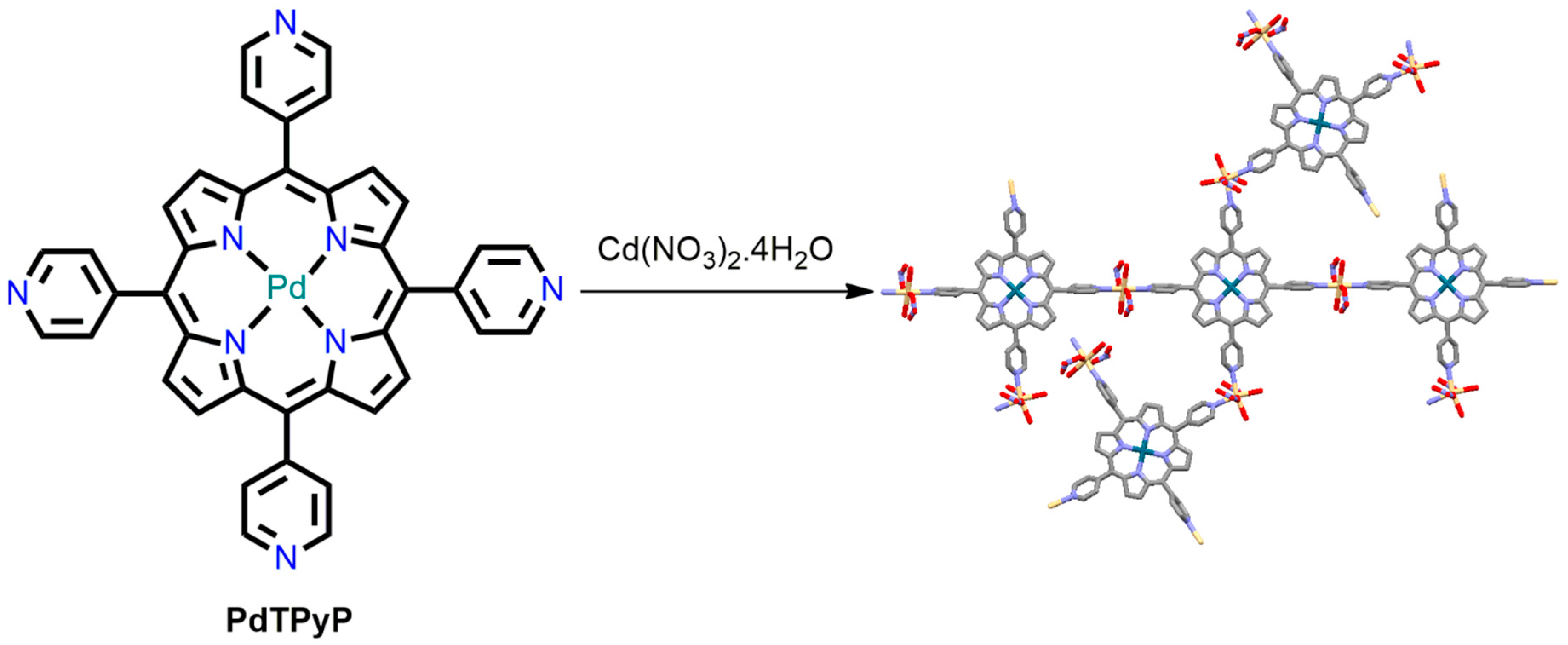

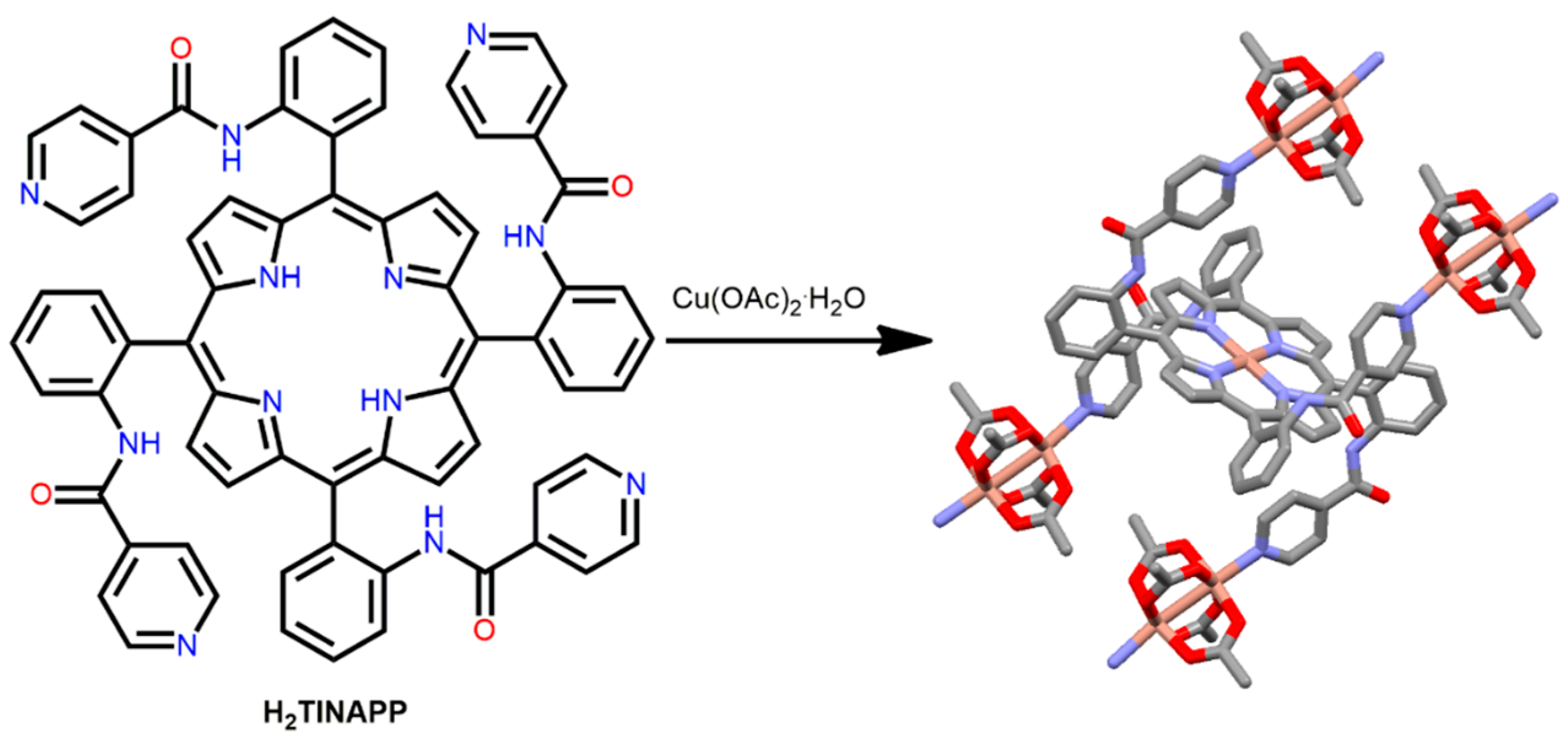

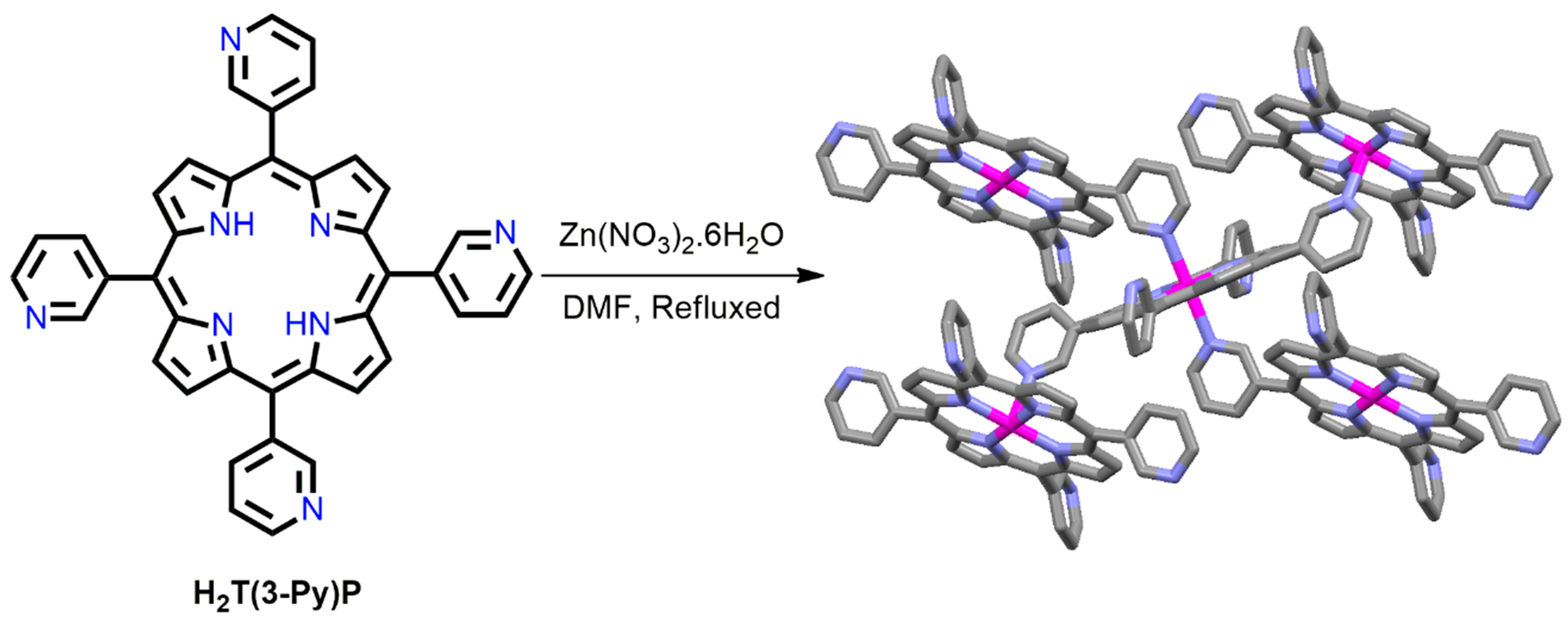

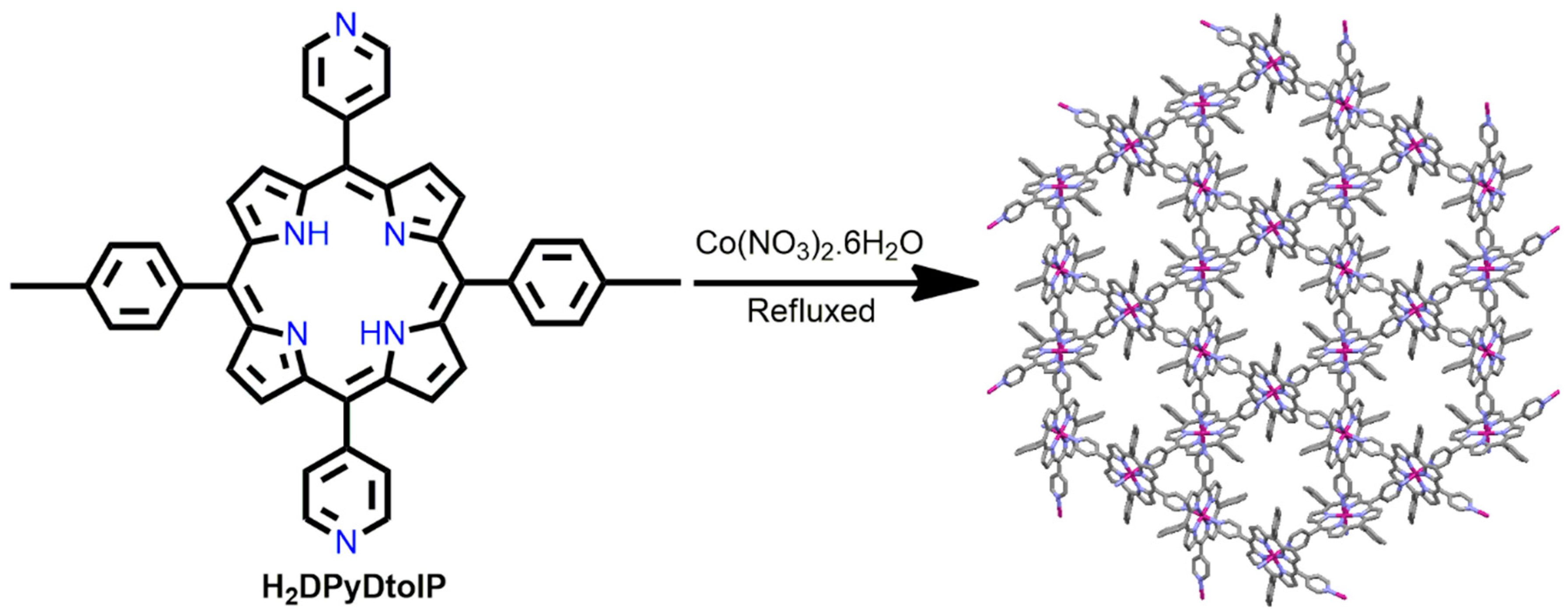
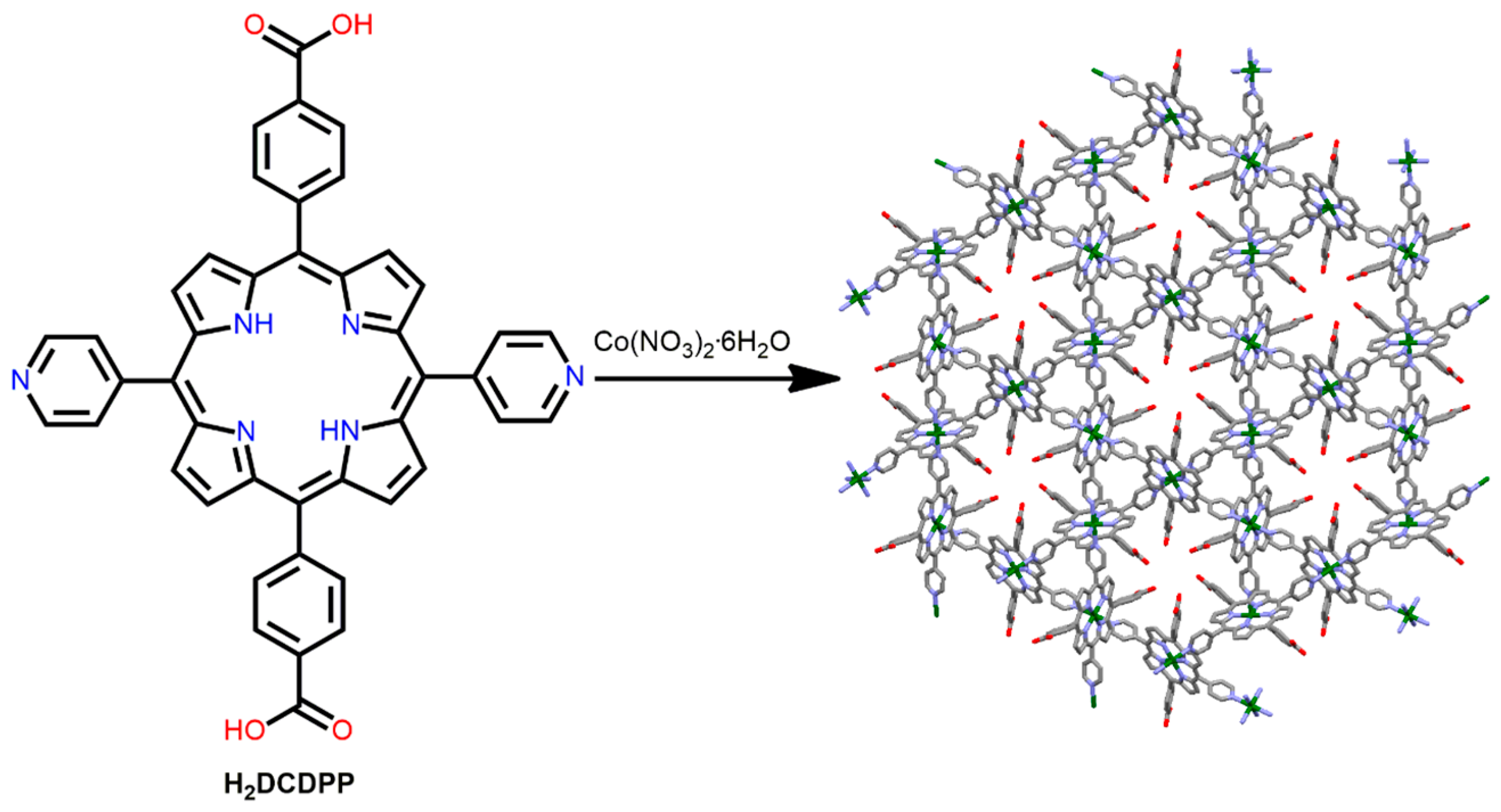

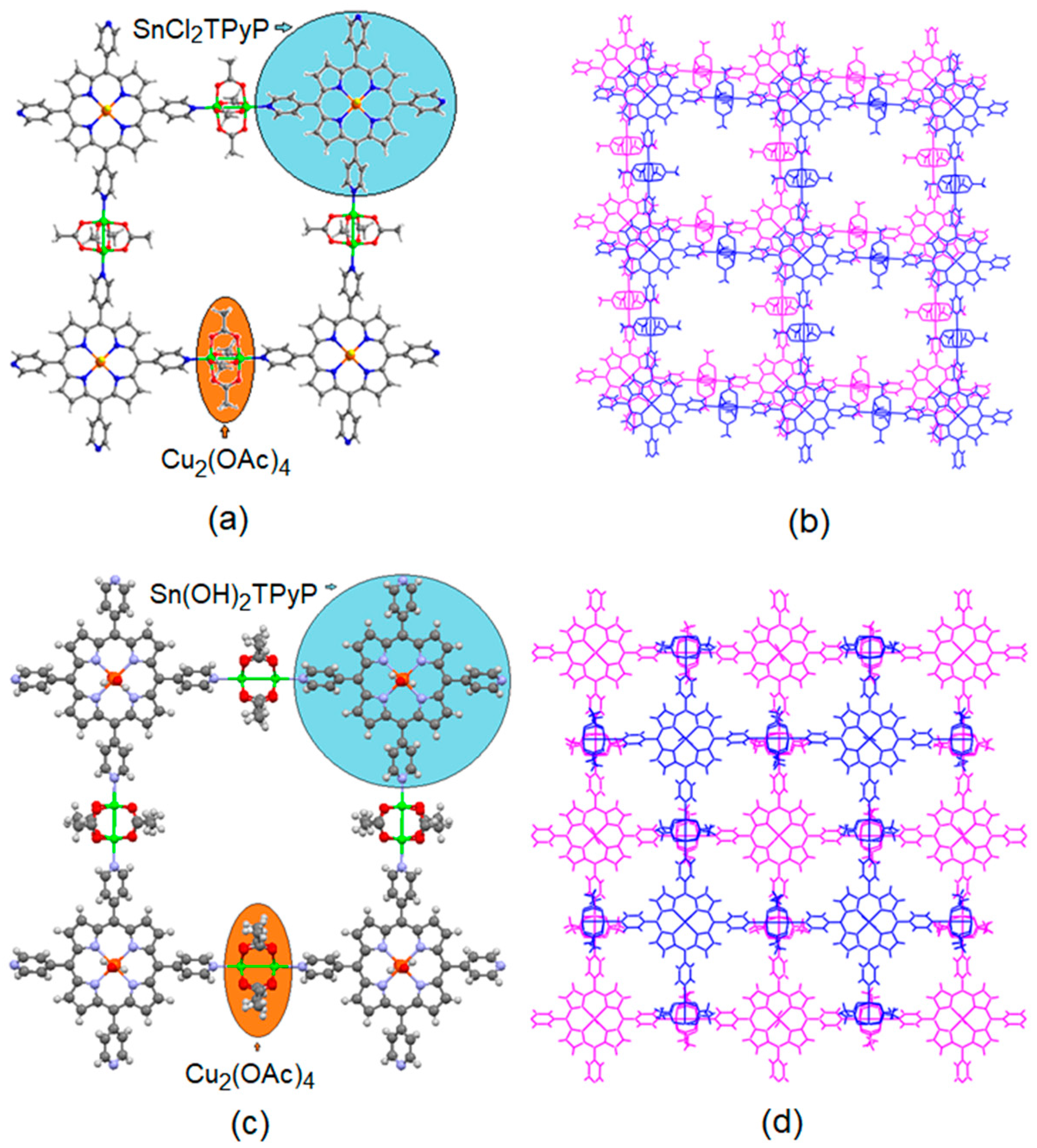
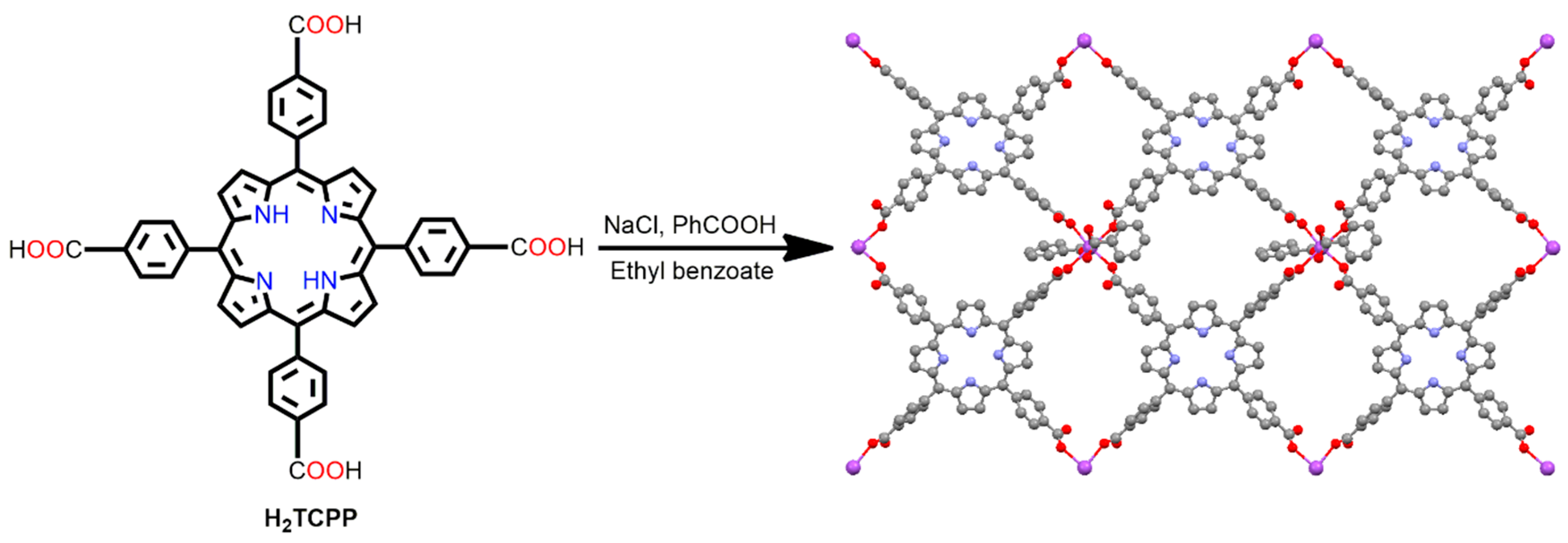
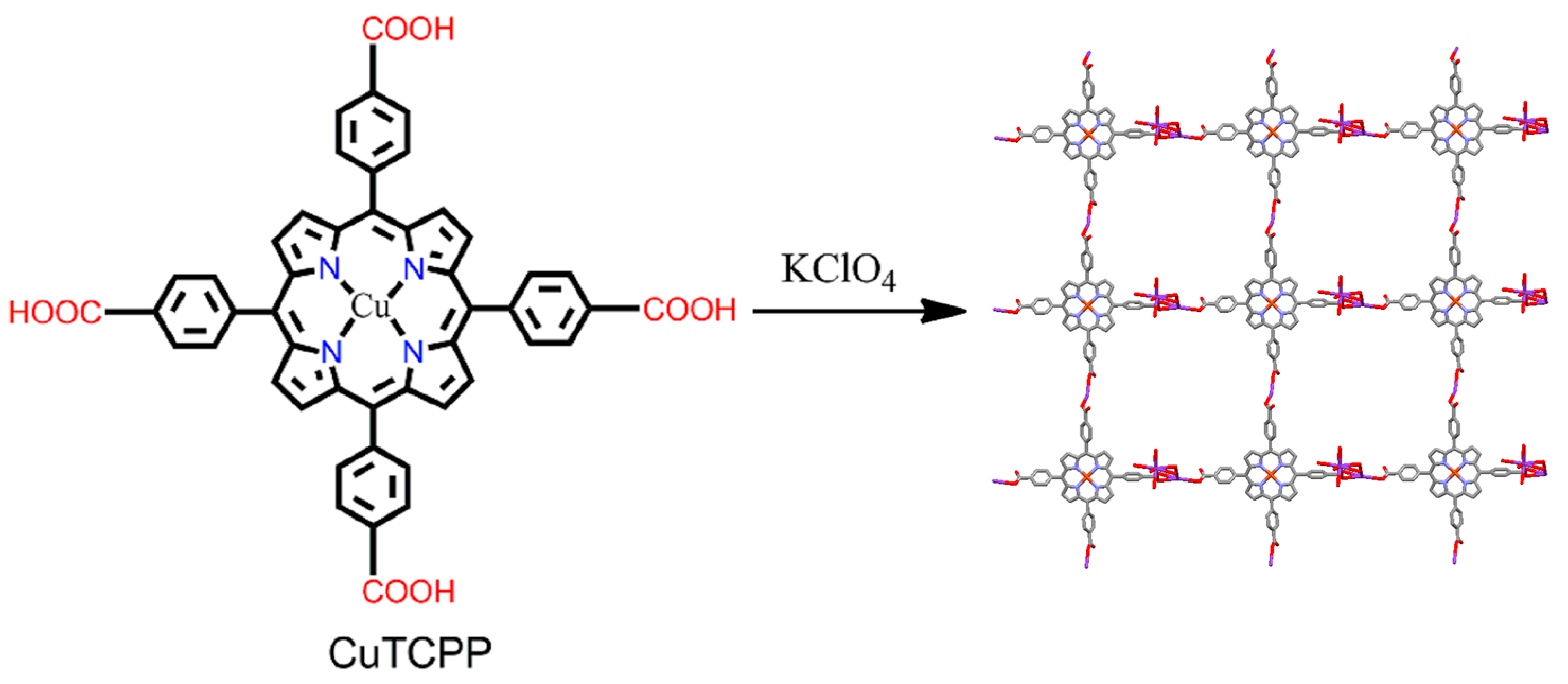
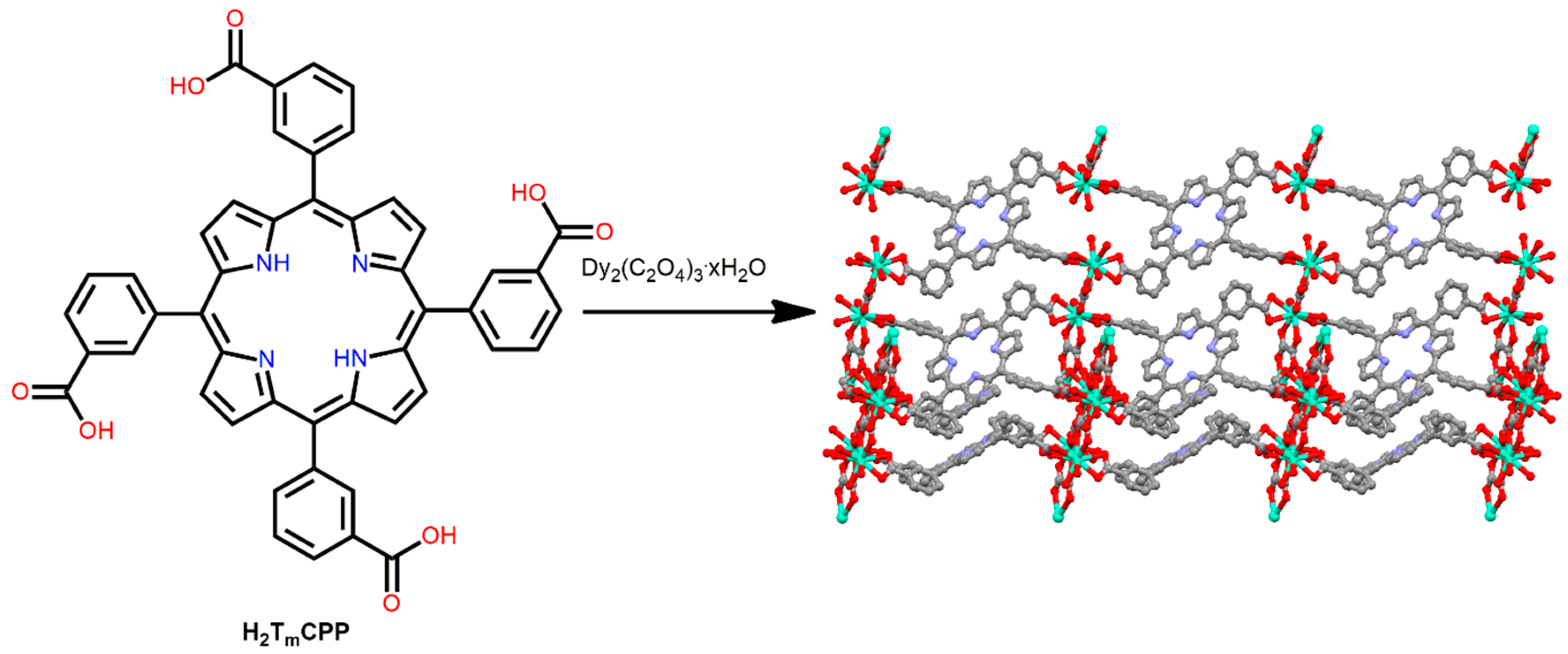


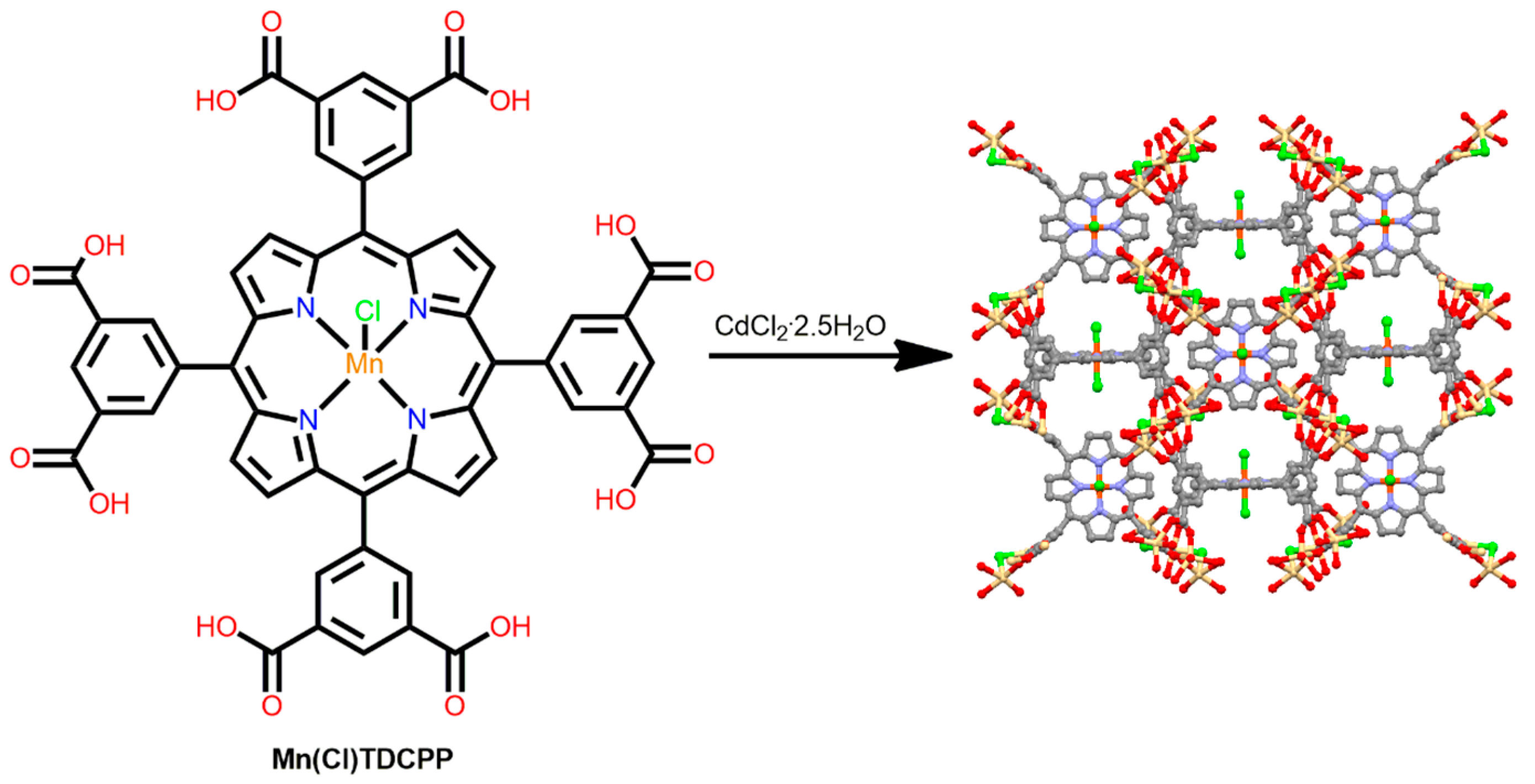
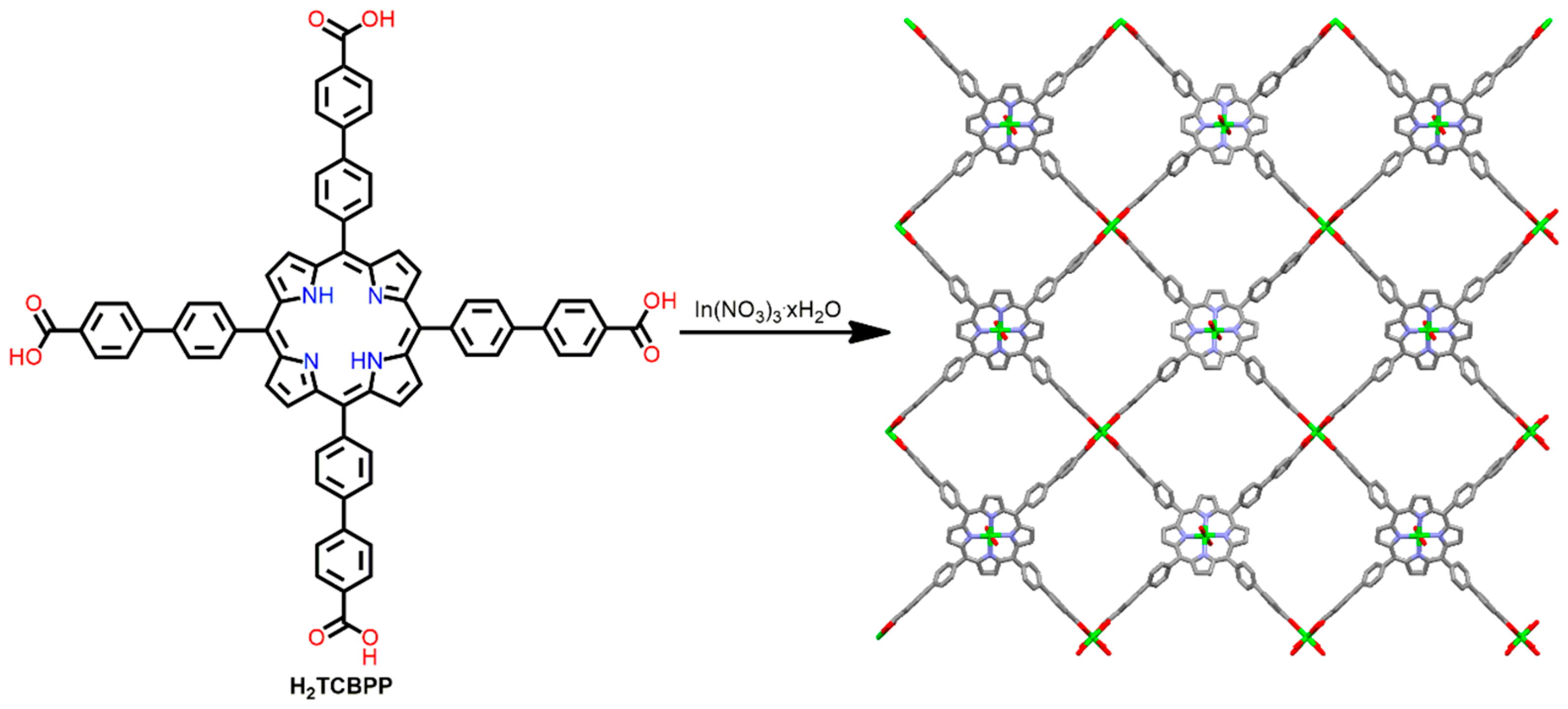



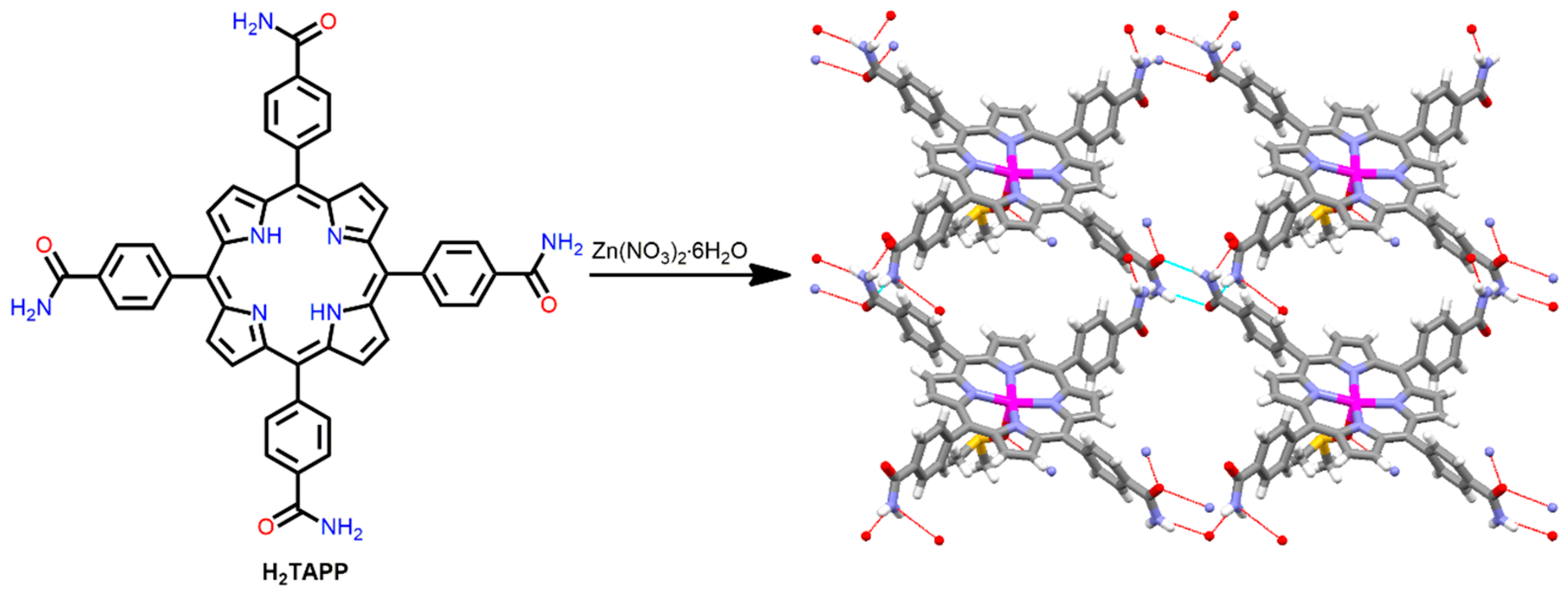



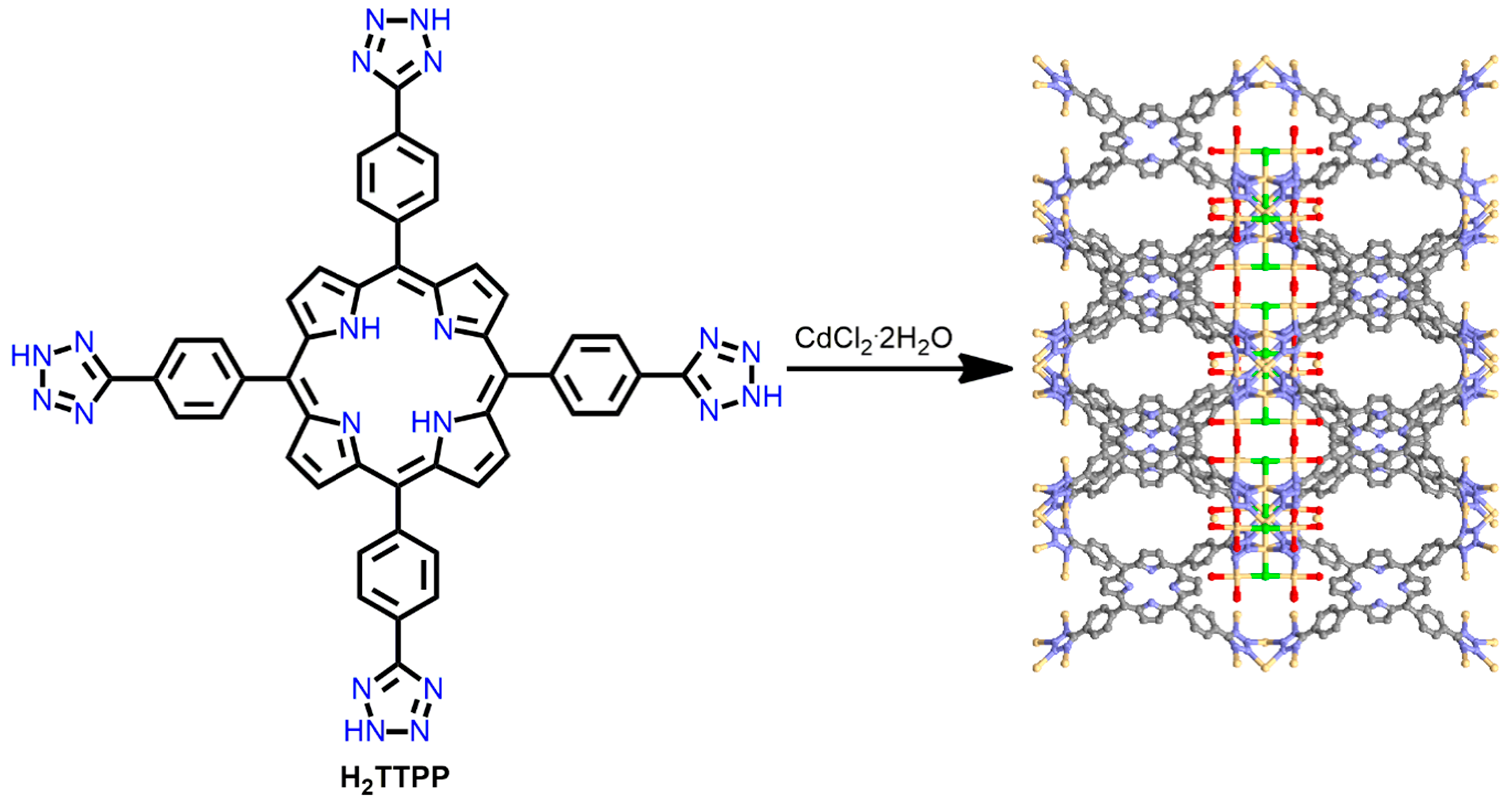



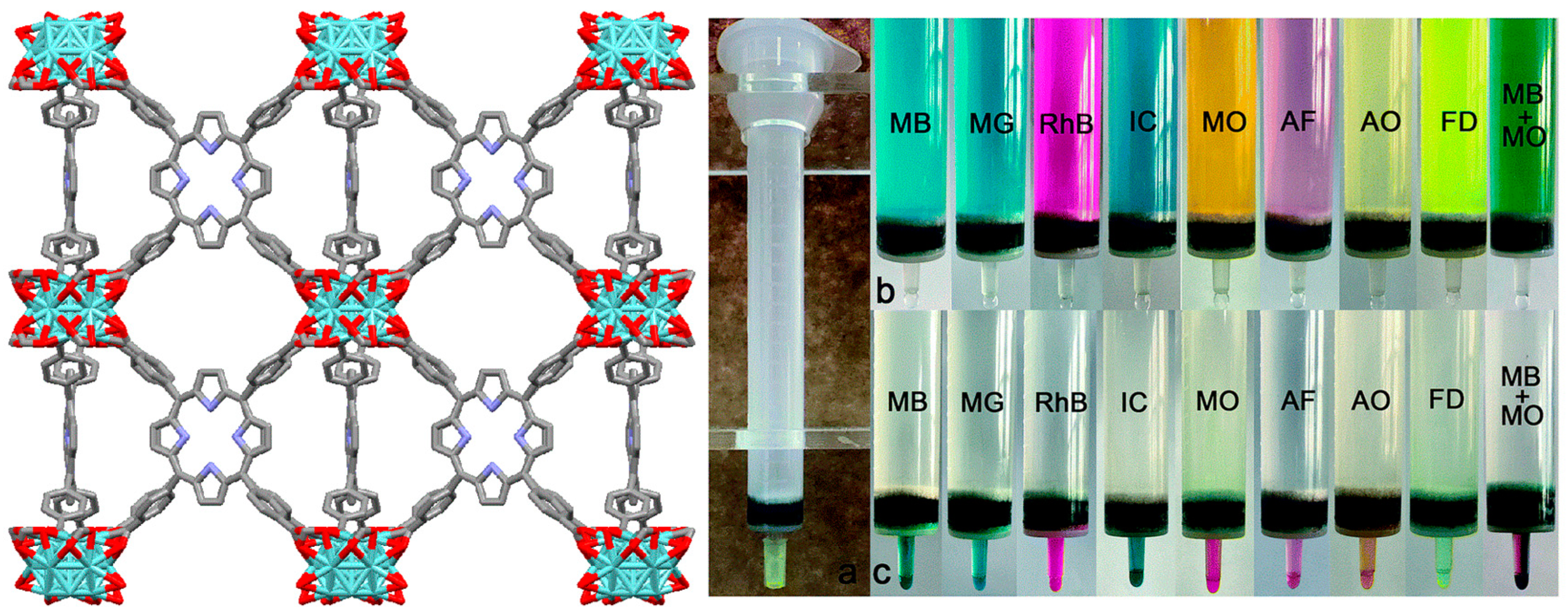
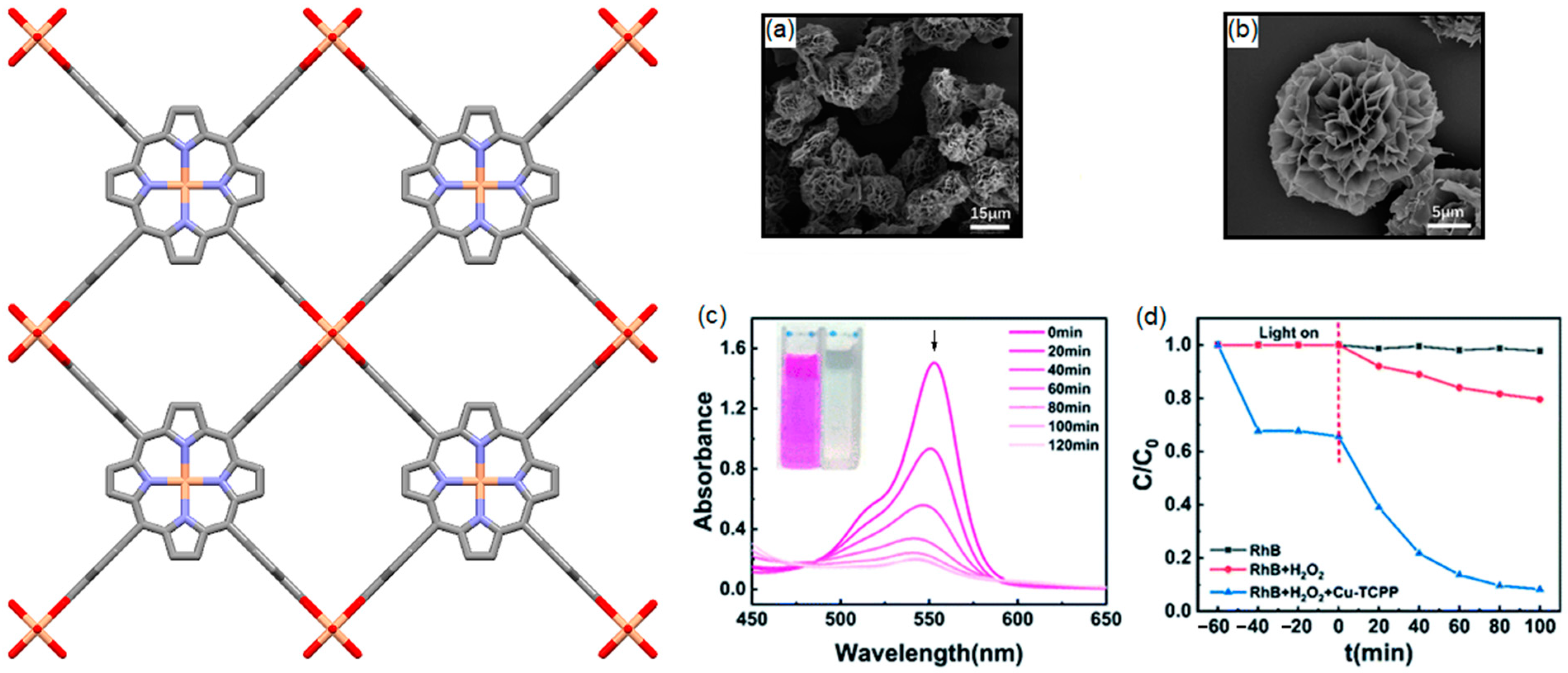
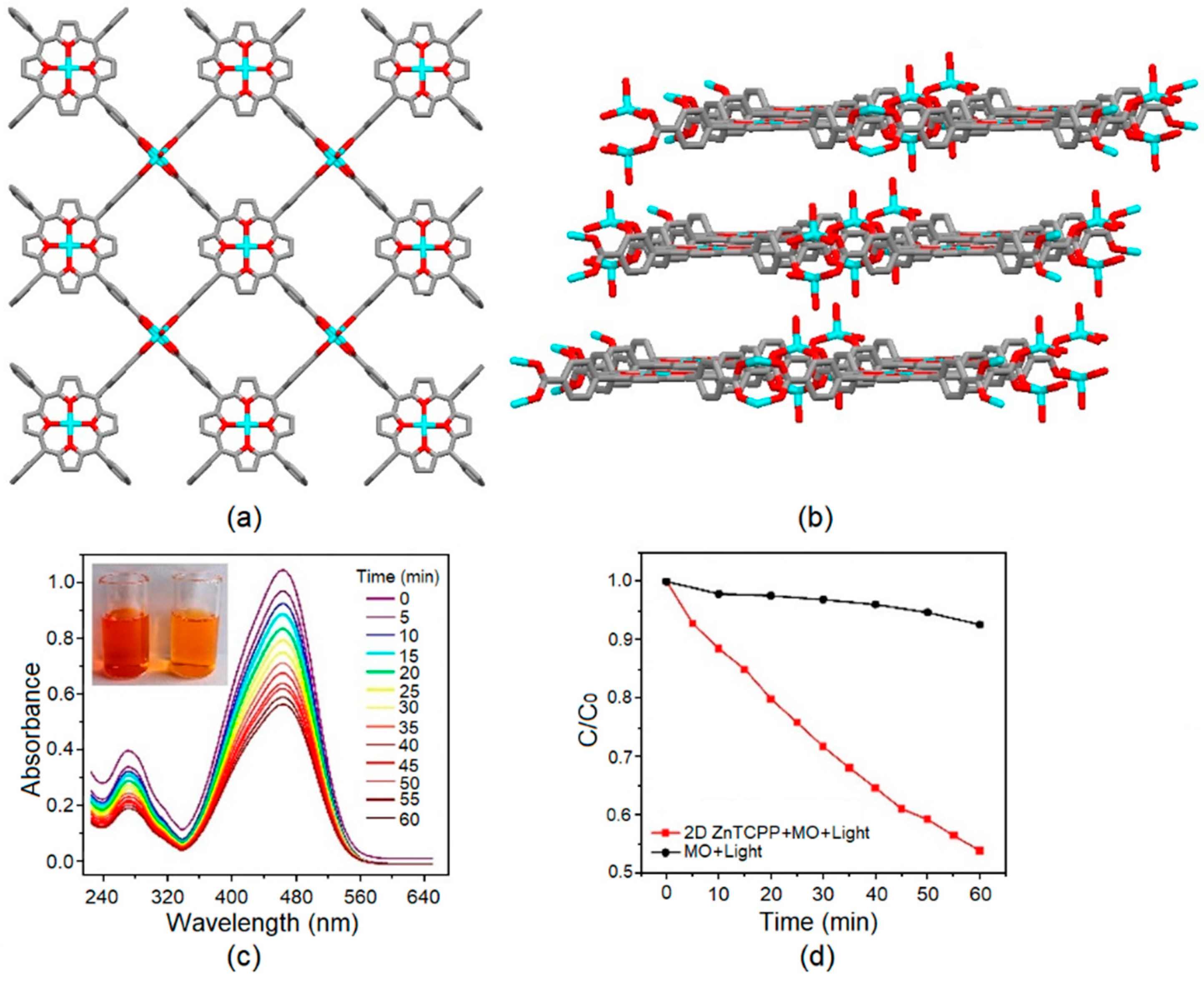
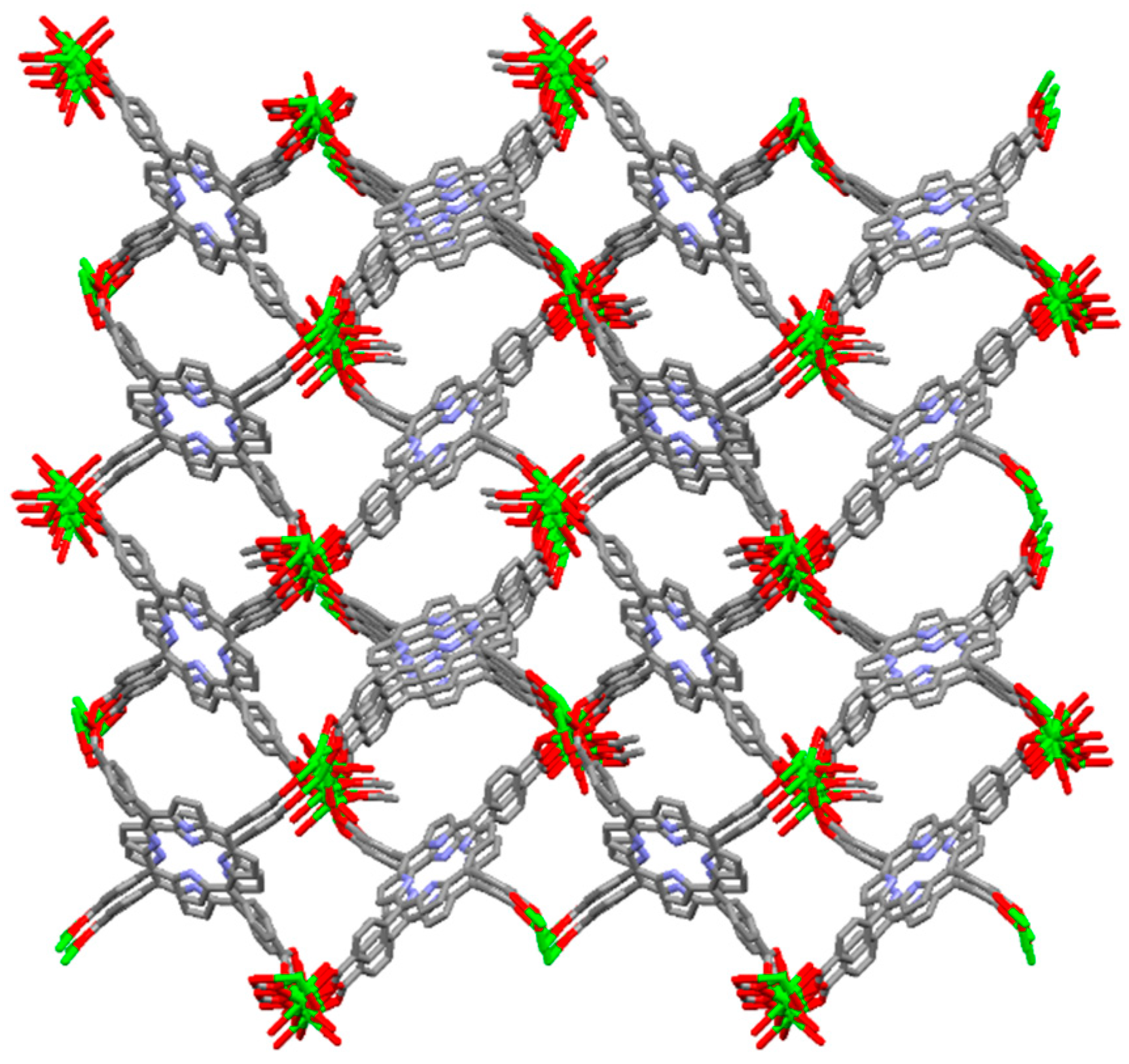
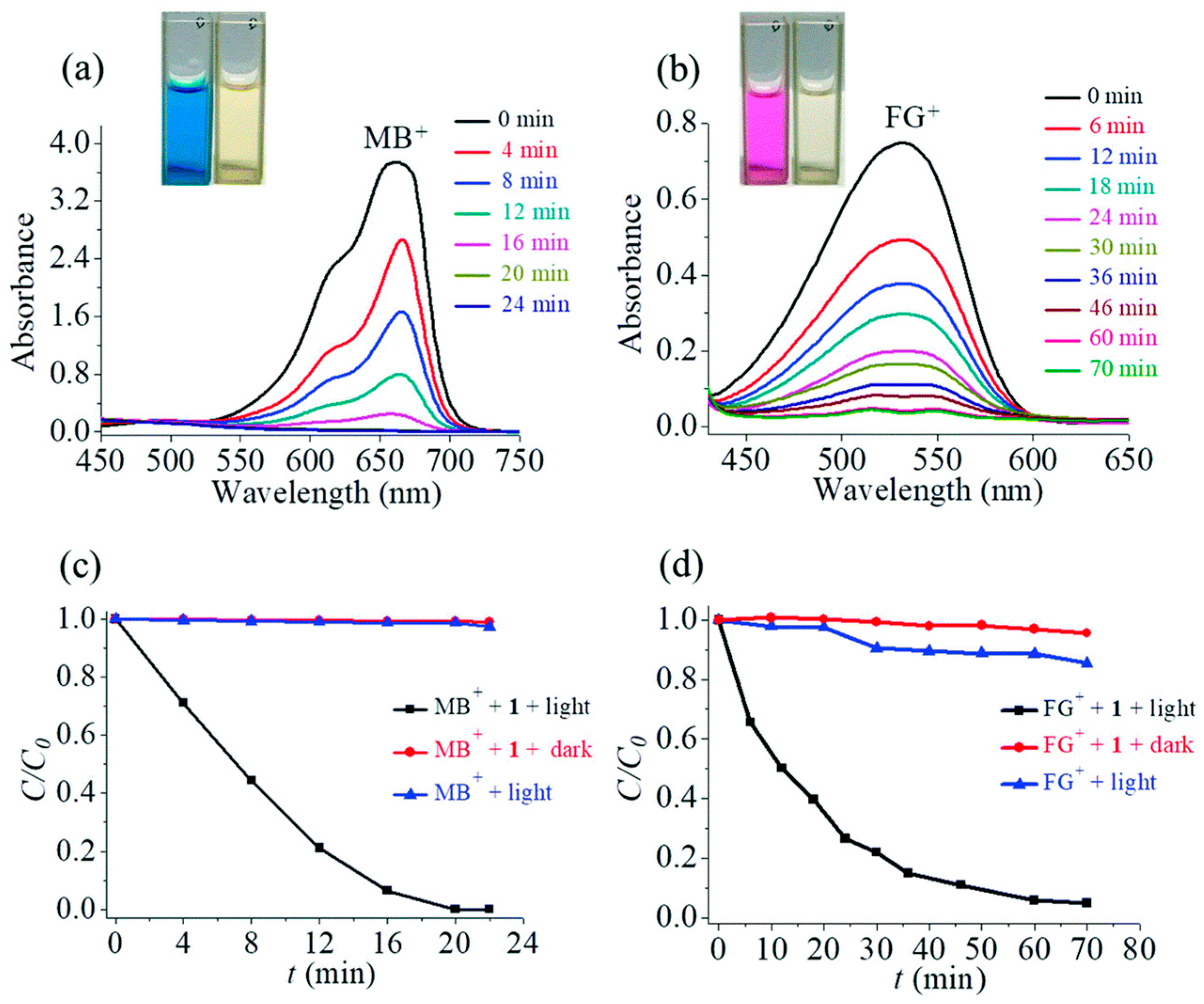
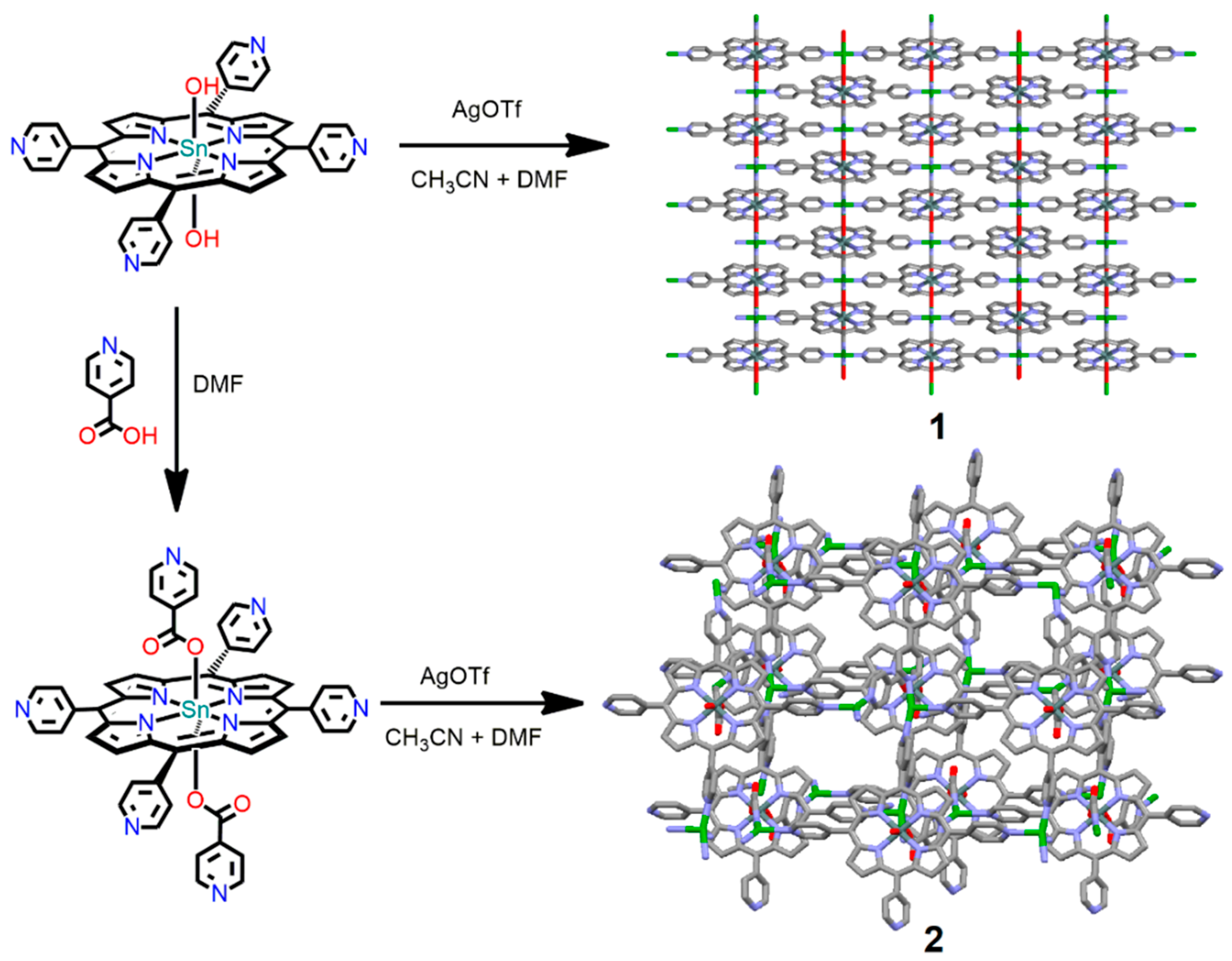
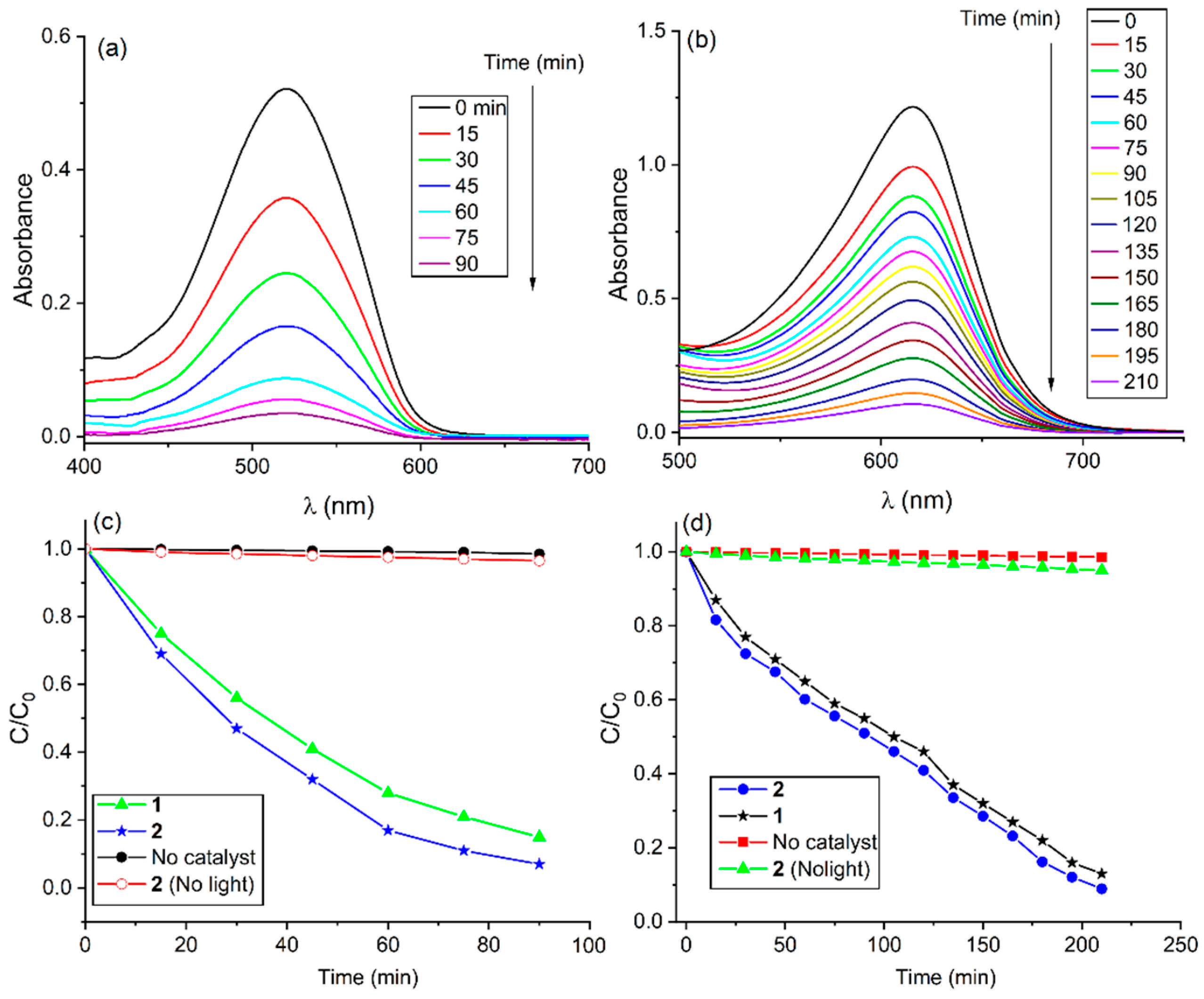
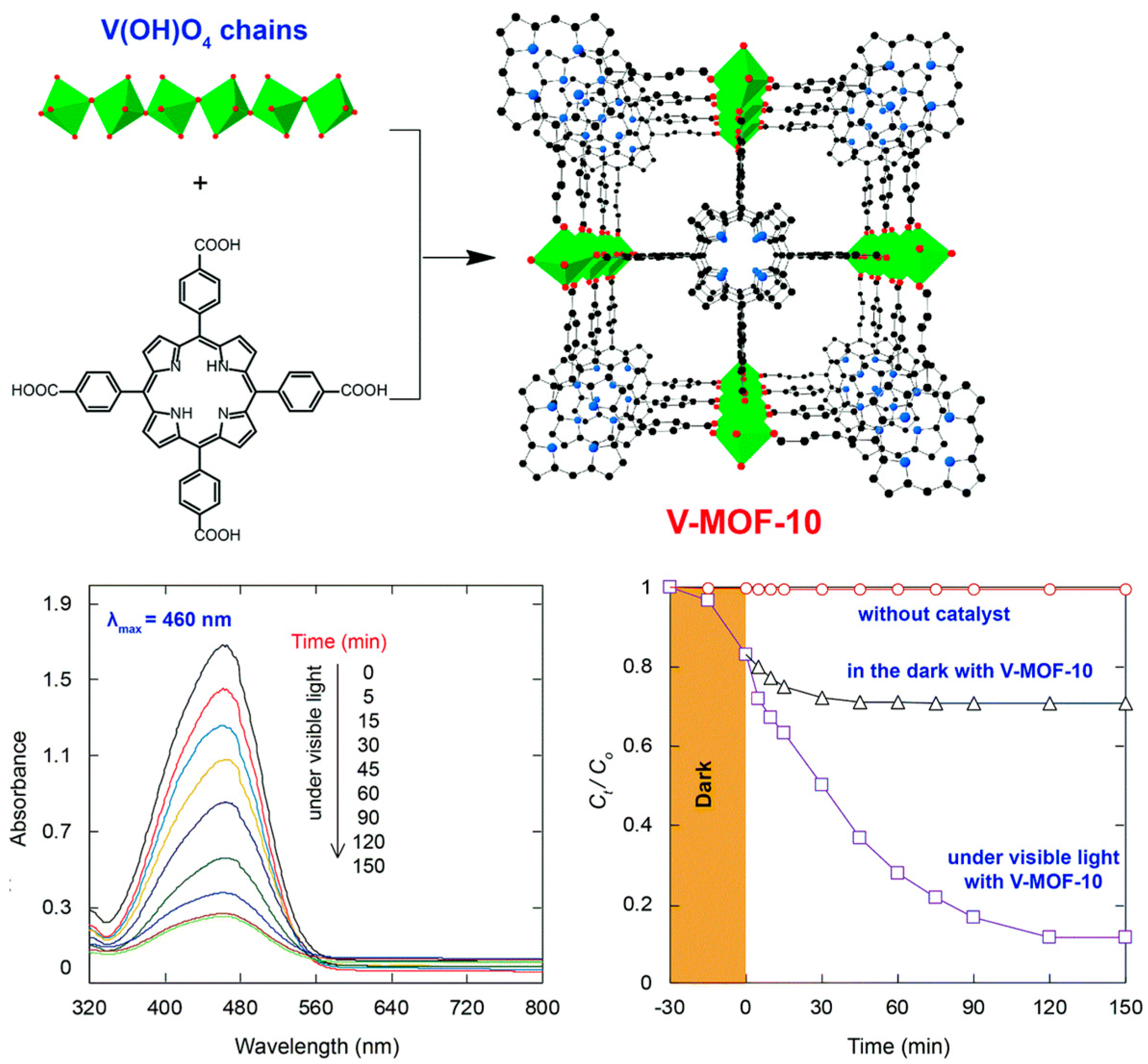
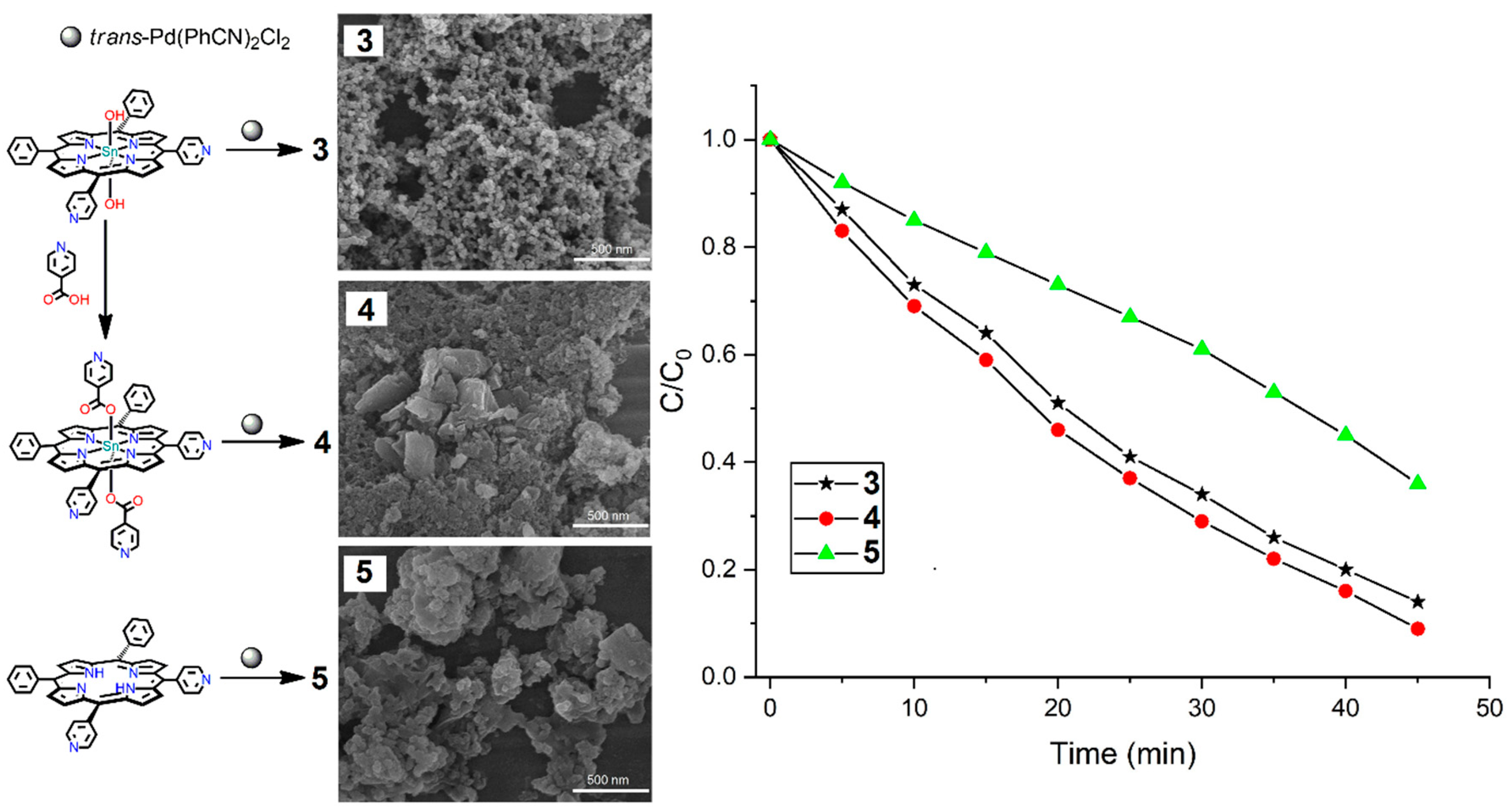
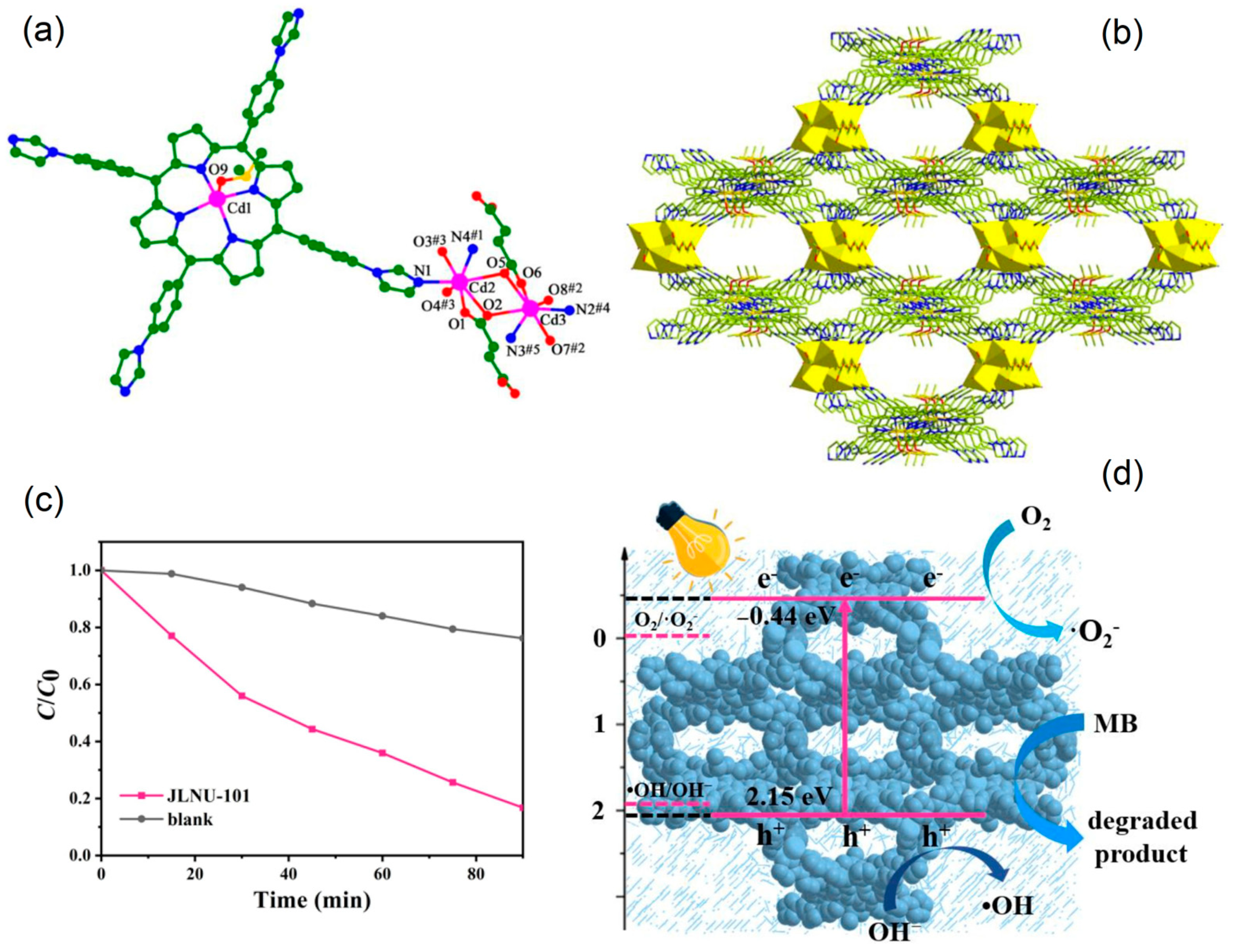
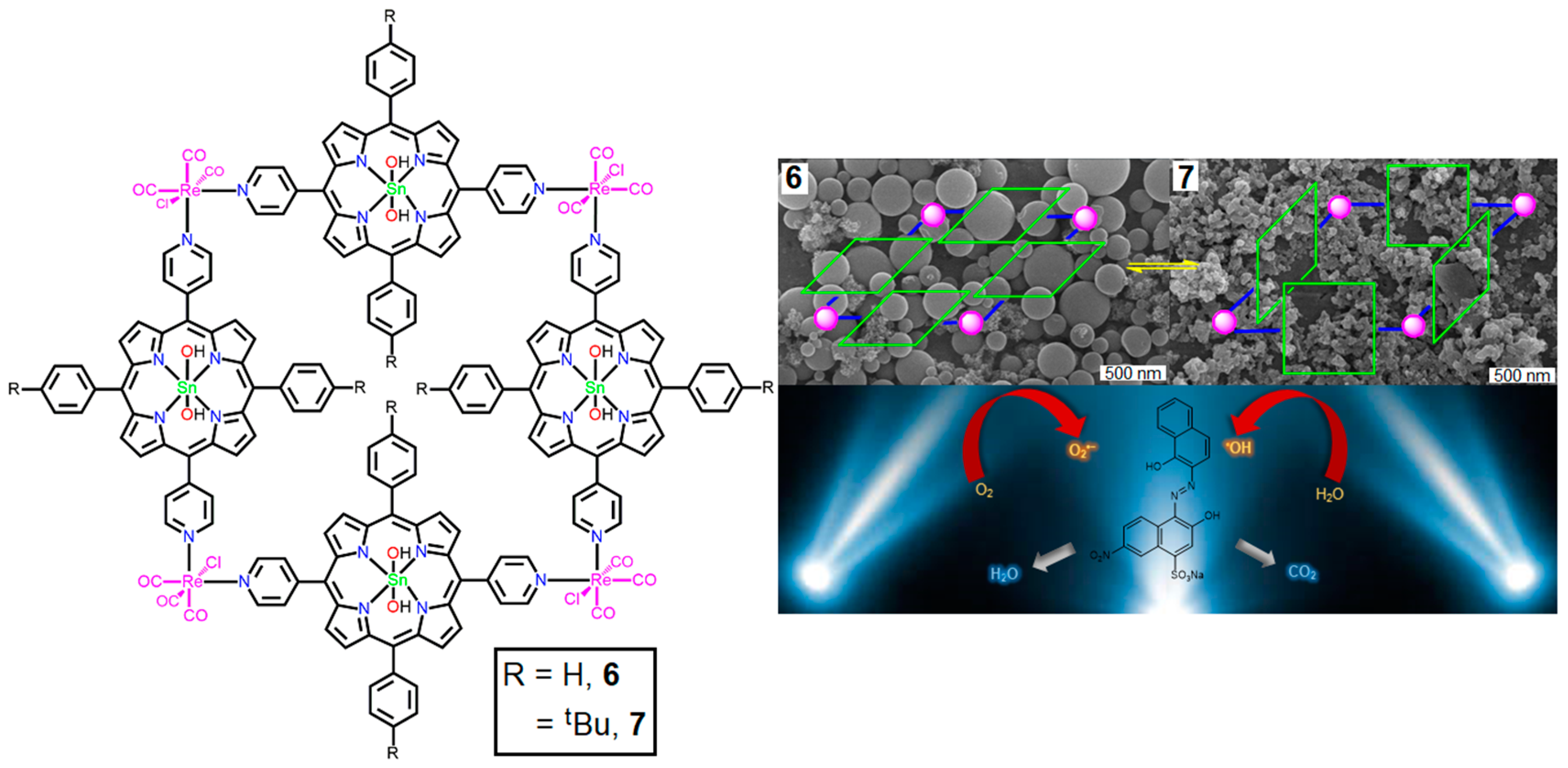
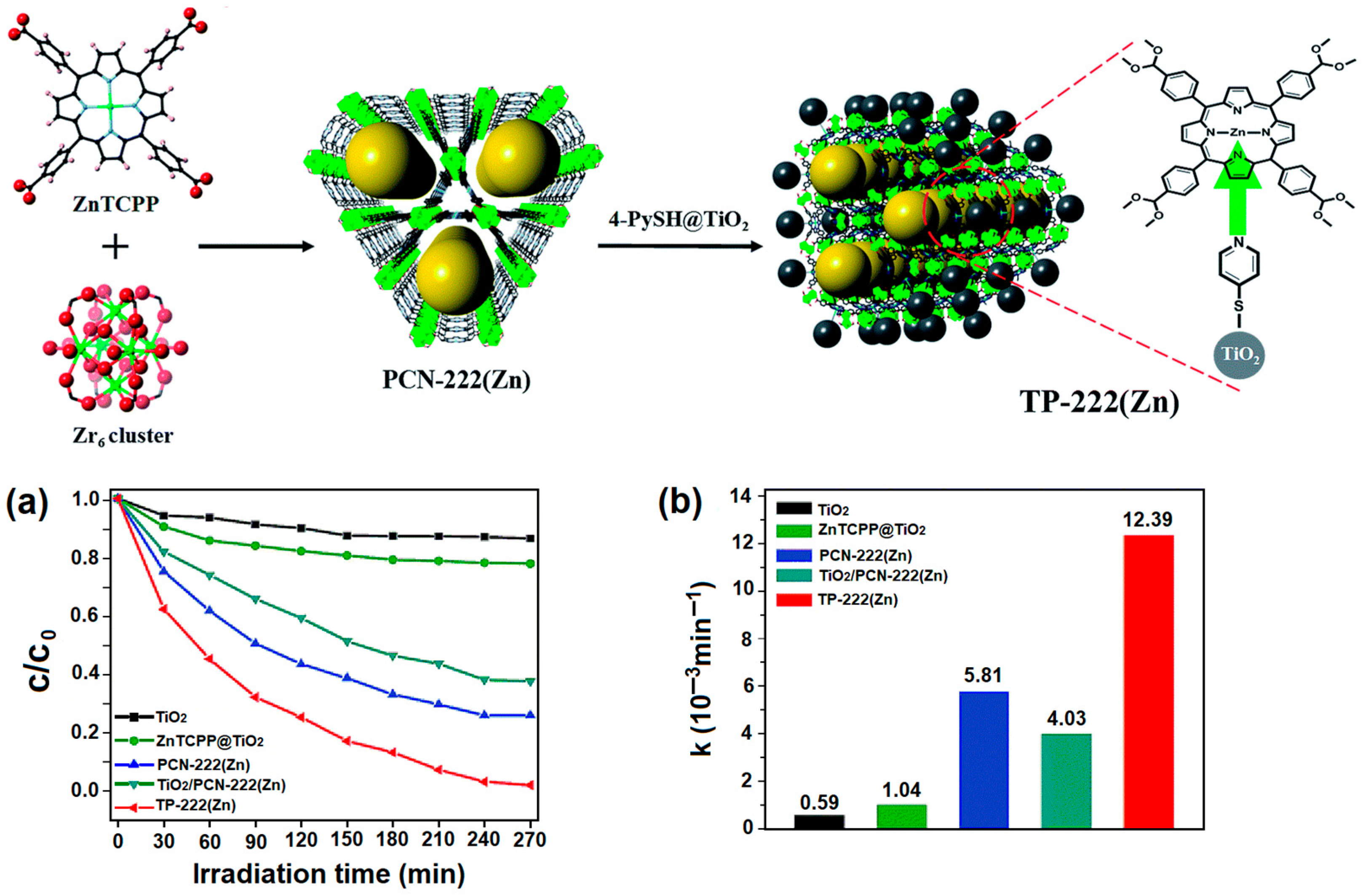

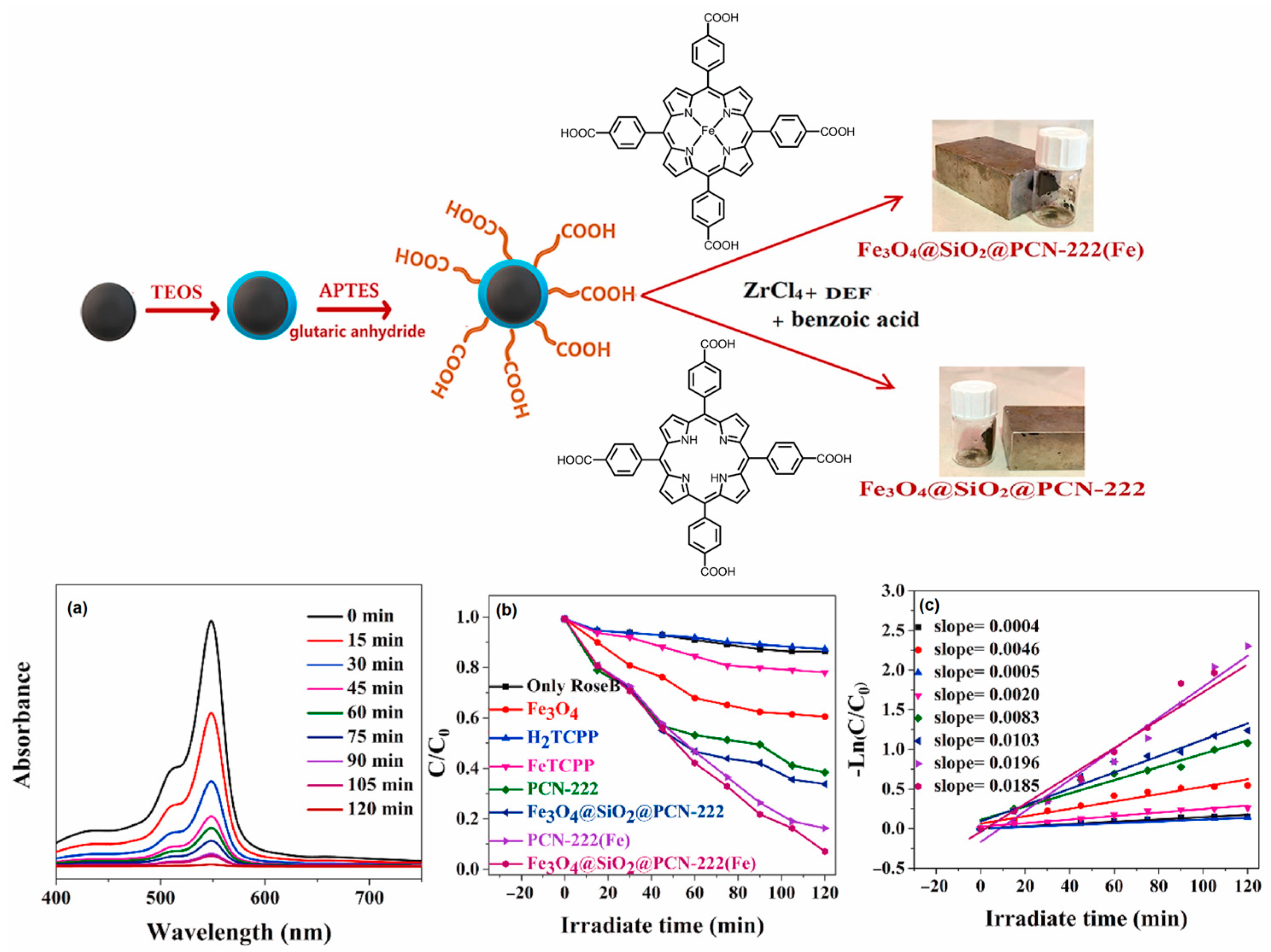
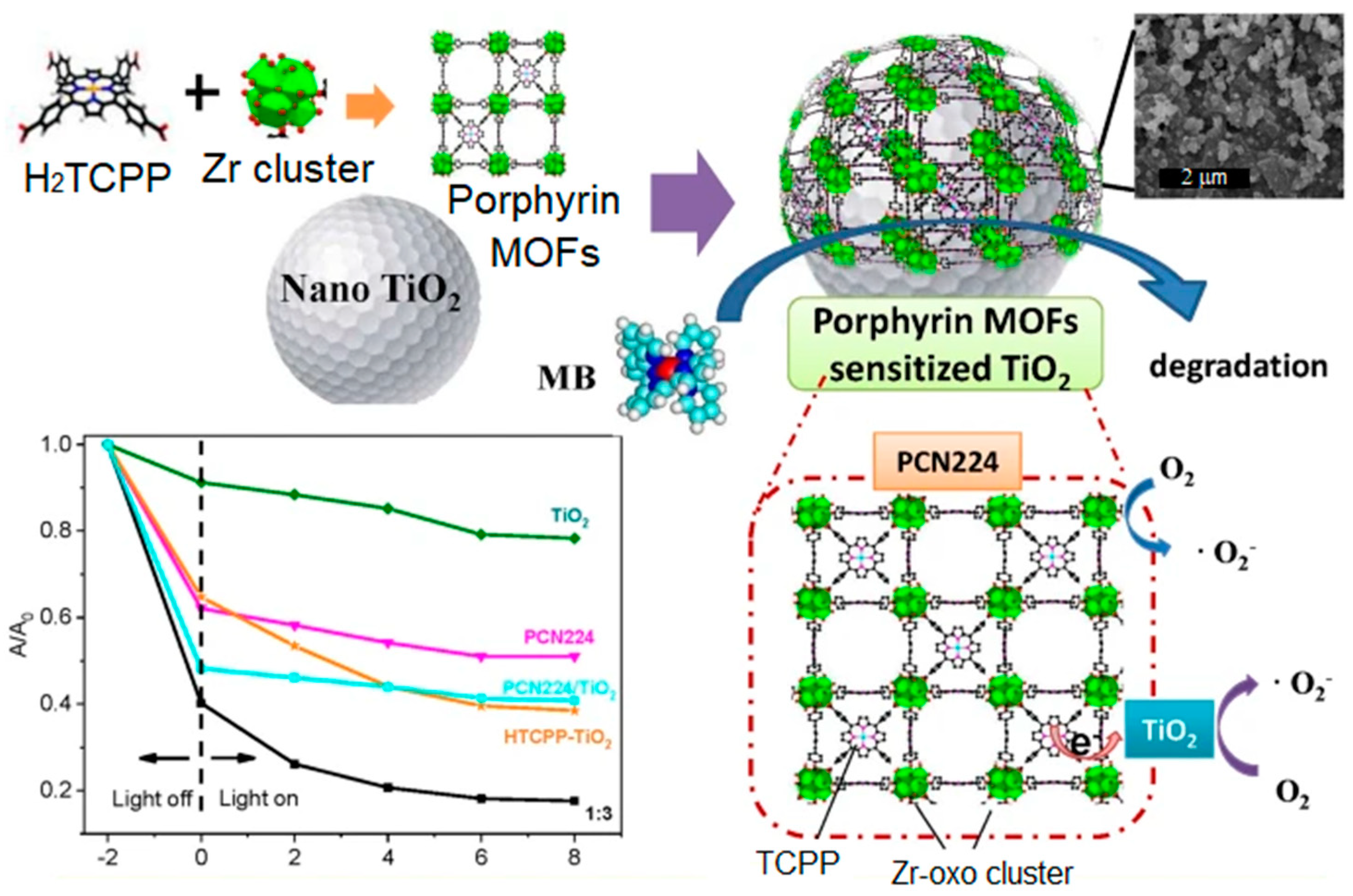
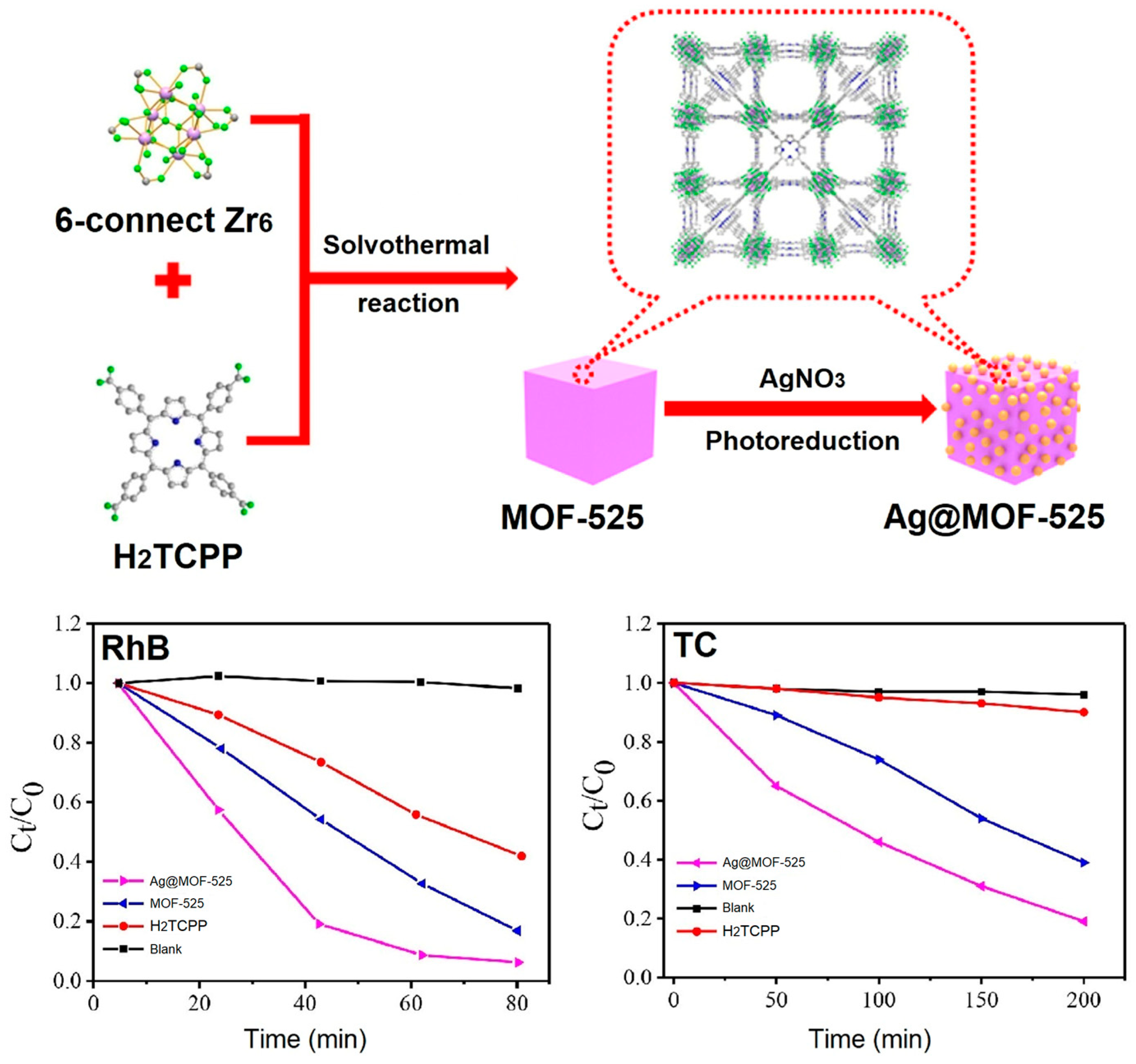
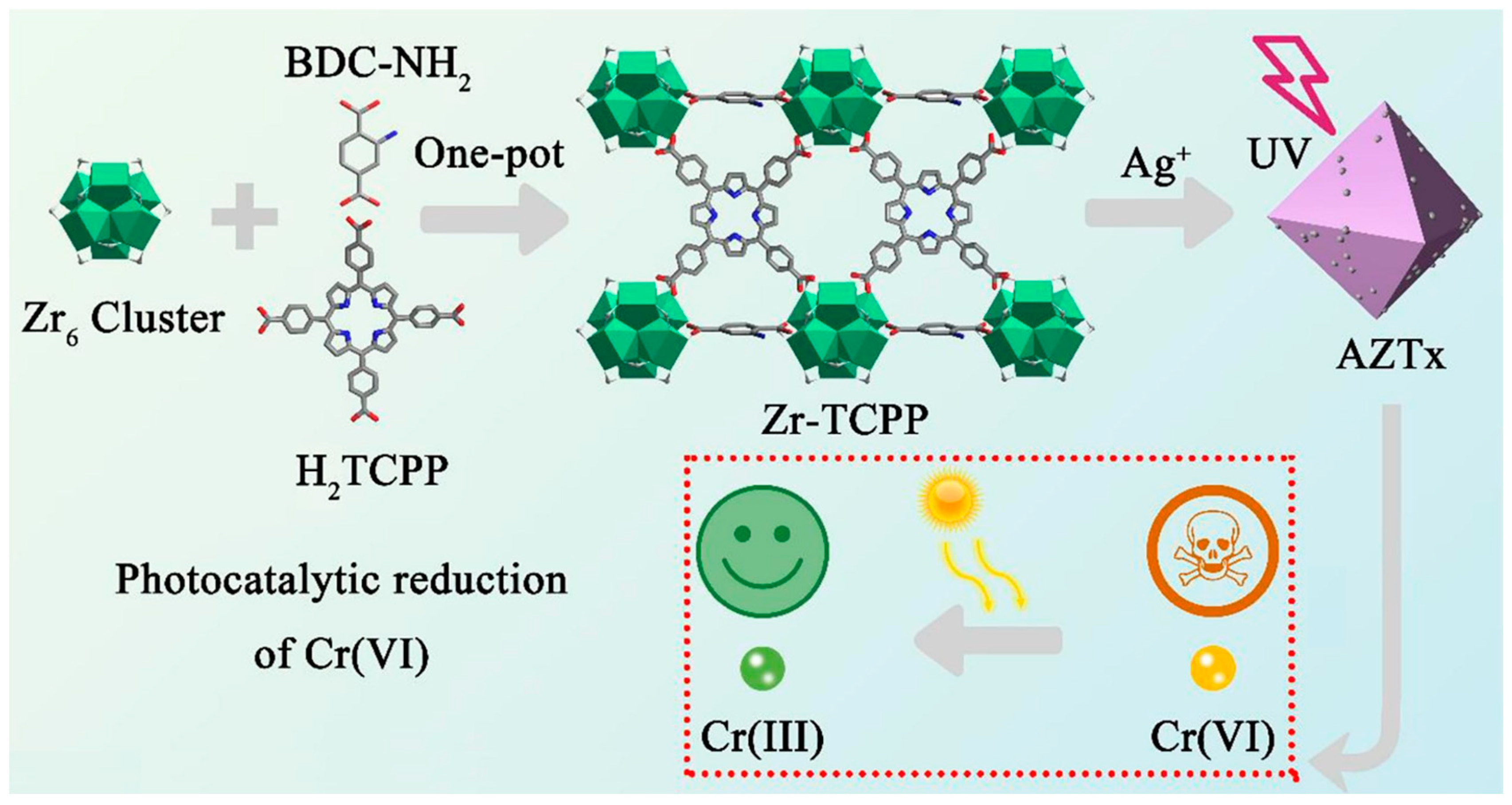


Disclaimer/Publisher’s Note: The statements, opinions and data contained in all publications are solely those of the individual author(s) and contributor(s) and not of MDPI and/or the editor(s). MDPI and/or the editor(s) disclaim responsibility for any injury to people or property resulting from any ideas, methods, instructions or products referred to in the content. |
© 2024 by the authors. Licensee MDPI, Basel, Switzerland. This article is an open access article distributed under the terms and conditions of the Creative Commons Attribution (CC BY) license (https://creativecommons.org/licenses/by/4.0/).
Share and Cite
Shee, N.K.; Kim, H.-J. Recent Developments in Porphyrin-Based Metal–Organic Framework Materials for Water Remediation under Visible-Light Irradiation. Int. J. Mol. Sci. 2024, 25, 4183. https://doi.org/10.3390/ijms25084183
Shee NK, Kim H-J. Recent Developments in Porphyrin-Based Metal–Organic Framework Materials for Water Remediation under Visible-Light Irradiation. International Journal of Molecular Sciences. 2024; 25(8):4183. https://doi.org/10.3390/ijms25084183
Chicago/Turabian StyleShee, Nirmal Kumar, and Hee-Joon Kim. 2024. "Recent Developments in Porphyrin-Based Metal–Organic Framework Materials for Water Remediation under Visible-Light Irradiation" International Journal of Molecular Sciences 25, no. 8: 4183. https://doi.org/10.3390/ijms25084183




